Contrasting Sources and Related Metallogeny of the Triassic and Jurassic Granitoids in the Chifeng–Chaoyang District, Northern Margin of the North China Craton: A Review with New Data
Abstract
:1. Introduction
2. Geological Background
3. Sources and Gold Mineralization of Taijiying Granite Porphyries
4. Geochemical Characteristics of Triassic and Jurassic Granitoids
4.1. Triassic Granitoids
4.2. Jurassic Granitoids
5. Characteristics of Sr–Nd–Hf–O Isotopes
5.1. Sr–Nd Isotope
5.2. Zircon Hf–O Isotope
6. Age and Types of Metallic Metallogeny
7. Discussion
7.1. Transition of the Granitoid Sources from the Triassic to the Jurassic
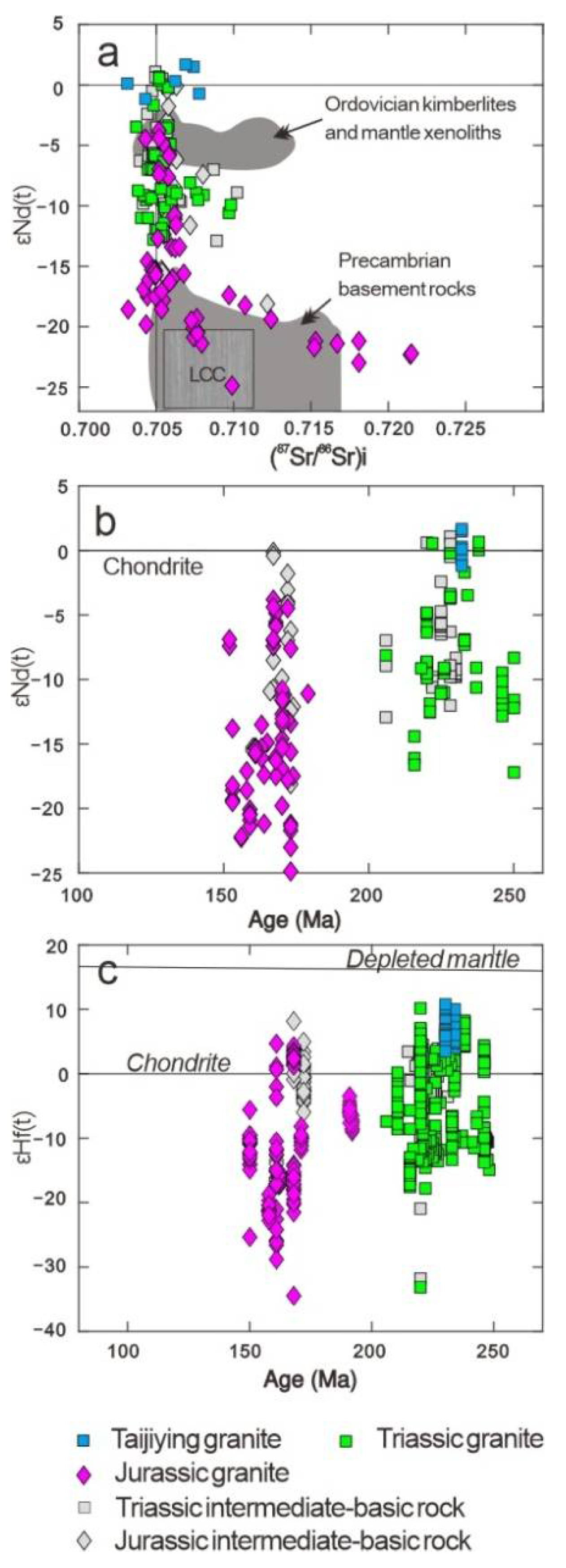
7.2. Relationship between the Sources and the Tectonic Setting
7.3. Possible Relationship between Sources and Metallogeny
8. Conclusions
Supplementary Materials
Author Contributions
Funding
Data Availability Statement
Acknowledgments
Conflicts of Interest
Contribution to the Field Statement
References
- Xu, Y.; Li, H.; Pang, C.; He, B. On the timing and duration of the destruction of the North China Craton. Chin. Sci. Bull. 2009, 54, 3379. [Google Scholar] [CrossRef]
- Zhu, R.X.; Yang, J.H.; Wu, F.Y. Timing of destruction of the North China Craton. Lithos 2012, 149, 51–60. [Google Scholar] [CrossRef]
- Wu, F.; Yang, J.; Xu, Y.; Wilde, S.; Walker, R. Destruction of the north china craton in the mesozoic. Annu. Rev. Earth Pl. Sc. 2019, 47, 173–195. [Google Scholar] [CrossRef]
- Yang, Q.; Wang, T.; Guo, L.; Tong, Y.; Zhang, L.; Zhang, J.; Hou, Z. Nd isotopic variation of Paleozoic—Mesozoic granitoids from the Da Hinggan Mountains and adjacent areas, NE Asia: Implications for the architecture and growth of continental crust. Lithos 2017, 272–273, 164–184. [Google Scholar] [CrossRef]
- Deng, J.; Wang, C.; Bagas, L.; Santosh, M.; Yao, E. Crustal architecture and metallogenesis in the south-eastern North China Craton. Earth-Sci. Rev. 2018, 182, 251–272. [Google Scholar] [CrossRef]
- Wang, X.; Wang, T.; Ke, C.; Yang, Y.; Li, J.; Li, Y.; Qi, Q.; Lv, X. Nd—Hf isotopic mapping of Late Mesozoic granitoids in the East Qinling orogen, central China: Constraint on the basements of terranes and distribution of Mo mineralization. J. Asian Earth Sci. 2015, 103, 169–183. [Google Scholar] [CrossRef]
- Yuan, J.; Zhang, H.; Tong, Y.; Gao, J.; Xiao, R. Sources of metals and fluids for the Taijiying gold deposit on the northern margin of the North China Craton. Ore Geol. Rev. 2021, 139, 104593. [Google Scholar] [CrossRef]
- Li, R.; Yang, J.; Wang, H.; Zhu, Y.; Sun, J.; Xu, L. Triassic lithospheric modification of the northern North China Craton: Evidences from the composite Kalaqin Batholith and ultramafic-mafic Heilihe Intrusive Complex in Inner Mongolia. Lithos 2020, 362–363, 105501. [Google Scholar] [CrossRef]
- Wang, T.; Hou, Z. Isotopic mapping and deep material probing (I): Revealing the compositional evolution of the lithosphere and crustal growth processes. Earth Sci. Front. 2018, 25, 1–19. [Google Scholar]
- Liu, Y.; Hu, Z.; Gao, S.; Gunther, D.; Xu, J.; Gao, C.; Chen, H. In situ analysis of major and trace elements of anhydrous minerals by LA-ICP-MS without applying an internal standard. Chem. Geol. 2008, 257, 34–43. [Google Scholar] [CrossRef]
- Zhai, M.G.; Santosh, M. The early Precambrian odyssey of the North China Craton: A synoptic overview. Gondwana Res. 2011, 20, 6–25. [Google Scholar] [CrossRef]
- Zhai, M.; Zhou, Y. General precambrian geology in China. In Precambrian Geology of China; Zhai, M., Ed.; CAS: Beijing, China, 2015; pp. 3–56. [Google Scholar]
- Zhao, G.; Cawood, P.A.; Li, S.; Wilde, S.A.; Sun, M.; Zhang, J.; He, Y.; Yin, C. Amalgamation of the North China Craton: Key issues and discussion. Precambrian Res. 2012, 222, 55–76. [Google Scholar] [CrossRef]
- Tang, J.; Xu, W.; Wang, F.; Ge, W. Subduction history of the Paleo-Pacific slab beneath Eurasian continent: Mesozoic-Paleogene magmatic records in Northeast Asia. Sci. China 2018, 61, 527–559. [Google Scholar] [CrossRef]
- Zhang, S.; Zhao, Y. Magmatic records of the late paleoproterozoic to neoproterozoic extensional and rifting events in the north china craton: A preliminary review. In Main Tectonic Events and Metallogeny of the North China Craton; Zhai, M., Zhao, Y., Zhao, T., Eds.; Springer: Singapore, 2016; pp. 359–391. [Google Scholar]
- Song, S.; Niu, Y.; Su, L.; Xia, X. Tectonics of the North Qilian orogen, NW China. Gondwana Res. 2013, 23, 1378–1401. [Google Scholar] [CrossRef]
- Windley, B.F.; Alexeiev, D.; Xiao, W.; Kröner, A.; Badarch, G. Tectonic models for accretion of the Central Asian Orogenic Belt. J. Geol. Soc. London. 2007, 164, 31–47. [Google Scholar] [CrossRef]
- Wu, F.; Ge, W.; Sun, D.; Lin, Q.; Zhou, Y. The Sm-Nd, Rb-Sr isotopic ages of the Archean granites in southern Jilin Province. Acta Petrol. Sinca. 1997, 13, 499–506. [Google Scholar]
- Zhang, K. Destruction of the North China Craton: Lithosphere folding-induced removal of lithospheric mantle? J. Geodyn. 2012, 53, 8–17. [Google Scholar] [CrossRef]
- Tang, L.; Santosh, M. Neoarchean-Paleoproterozoic terrane assembly and Wilson cycle in the North China Craton: An overview from the central segment of the Trans-North China Orogen. Earth-Sci. Rev. 2018, 182, 1–27. [Google Scholar] [CrossRef]
- Zeng, Q.; Liu, J.; Zhang, Z.; Zhang, W.; Chu, S.; Zhang, S.; Wang, Z.; Duan, X. Geology, fluid inclusion, and sulfur isotope studies of the chehugou porphyry molybdenum–copper deposit, xilamulun metallogenic belt, NE china. Resour. Geol. 2011, 61, 241–258. [Google Scholar] [CrossRef]
- Wang, X.S.; Zheng, Y. 40Ar/39Ar age constraints on the ductile deformation of the detachment system of the Louzidian core complex, southern Chifeng, China. Geol. Rev. 2005, 51, 574–582, (In Chinese with English abstract). [Google Scholar]
- LBGMR. Regional Geology of Liaoning Province; Geological Publishing House: Beijing, China, 1989; pp. 317–520. [Google Scholar]
- Liu, S.; Santosh, M.; Wang, W.; Bai, X.; Yang, P. Zircon U-Pb chronology of the Jianping Complex: Implications for the Precambrian crustal evolution history of the northern margin of North China Craton. Gondwana Res. 2011, 20, 48–63. [Google Scholar] [CrossRef]
- Liu, L.; Gu, X.; Zhang, Y.; Ouyang, X.; Wang, L.; Gao, L. Genesis of the Jinchanggouliang gold deposit, Chifeng, China: Constraints from fluid inclusions and isotopic geochemistry. Ore Geol. Rev. 2019, 115, 103180. [Google Scholar] [CrossRef]
- Wang, W.; Liu, S.; Bai, X.; Yang, P.; Li, Q.; Zhang, L. Geochemistry and zircon U-Pb-Hf isotopic systematics of the Neoarchean Yixian—Fuxin greenstone belt, northern margin of the North China Craton: Implications for petrogenesis and tectonic setting. Gondwana Res. 2011, 20, 64–81. [Google Scholar] [CrossRef]
- Xiong, L.; Shi, W.; Li, H.; Tian, N.; Chen, C.; Zhou, H.Z.; Zhao, S.Q.; Li, P.Y. Geochemistry, Sr-Nd-Hf isotopes and petrogenesis of Mid-Late triassic baizhangzi granitic intrusive rocks in eastern Hebei-Western liaoning province. Earth Sci. 2017, 42, 207–222, (In Chinese with English abstract). [Google Scholar]
- Fu, L.; Wei, J.; Kusky, T.; Chen, H.; Tan, J.; Li, Y.; Kong, L.; Jiang, Y. Triassic shoshonitic dykes from the northern North China craton: Petrogenesis and geodynamic significance. Geol. Mag. 2012, 149, 39–55. [Google Scholar] [CrossRef]
- Ma, Y.; Zeng, Q.; Song, B.; Du, J.; Yang, F.; Zhao, Y. Shrimp U-Pb dating of zircon from Panshan granitoid pluton in Yanshan orogenic belt and its tectonic implications. Acta Petrol. Sin. 2007, 23, 547–556, (In Chinese with English abstract). [Google Scholar]
- Ye, H.; Zhang, S.; Zhao, Y.; Wu, F. Petrogenesis and emplacement deformation of the Late Triassic Dushan composite batholith in the Yanshan fold and thrust belt: Implication for the tectonic settings of the northern margin of the North China Craton during the Early Mesozoic. Earth Sci. Front. 2014, 21, 275–292, (In Chinese with English abstract). [Google Scholar]
- Han, B.F.; Kagami, H.; Li, H.M. Age and Nd-Sr isotopic geochemistry of the Guangtoushan alkaline granite, Hebei province, China: Implications for early Mesozoic crust-mantle interaction in North China Block. Acta Petrol. Sin. 2004, 20, 1375–1388. [Google Scholar]
- Cai, J.; Yan, G.; Mou, B.; Ren, K.; Li, F.; Yang, B. Geochronology and geochemistry of sungezhuang alkaline complex in jixian county, tianjin. J. Jilin Univ. (Earth Sci. Ed.) 2011, 41, 1901–1913. [Google Scholar]
- Yang, J.H.; Sun, J.F.; Zhang, M.; Wu, F.Y.; Wilde, S.A. Petrogenesis of silica-saturated and silica-undersaturated syenites in the northern North China Craton related to post-collisional and intraplate extension. Chem. Geol. 2012, 328, 149–167. [Google Scholar] [CrossRef]
- Zhang, S.H.; Zhao, Y.; Davis, G.A.; Ye, H.; Wu, F. Temporal and spatial variations of Mesozoic magmatism and deformation in the North China Craton: Implications for lithospheric thinning and decratonization. Earth-Sci. Rev. 2014, 131, 49–87. [Google Scholar] [CrossRef]
- Elhlou, S.; Belousova, E.; Griffin, W.L.; Pearson, N.J.; O′Reilly, S.Y. Trace element and isotopic composition of GJ-red zircon standard by laser ablation. Geochim. Et Cosmochim. Acta Suppl. 2006, 70, A158. [Google Scholar] [CrossRef]
- Belousova, E.; Griffin, W.; O′Reilly, S.Y.; Fisher, N. Igneous zircon: Trace element composition as an indicator of source rock type. Contrib. Mineral. Petrol. 2002, 143, 602–622. [Google Scholar] [CrossRef]
- Le Maitre, R.W. Igneous Rocks: A Classification and Glossary of Terms, 2nd ed.; Cambridge University Press: Cambridge, UK, 2002. [Google Scholar]
- Taylor, S.R. McLennan SM: The Continental Crust: Its Composition and Evolution. 1985. Available online: https://www.osti.gov/biblio/6582885 (accessed on 10 August 2022).
- Sun, S.S.; McDonough, W. Chemical and isotopic systematics of oceanic basalts: Implications for mantle composition and processes. Geol. Soc. Lond. Spec. Publ. 1989, 42, 313–345. [Google Scholar] [CrossRef]
- Whalen, J.B.; Currie, K.L.; Chappell, B.W. A-type granites: Geochemical characteristics, discrimination and petrogenesis. Contrib. Mineral. Petrol. 1987, 95, 407–419. [Google Scholar] [CrossRef]
- Valley, J.W.; Kinny, P.D.; Schulze, D.J.; Spicuzza, M.J. Zircon megacrysts from kimberlite: Oxygen isotope variability among mantle melts. Contrib. Mineral. Petrol. 1998, 1–11. [Google Scholar] [CrossRef]
- Fan, W.; Jiang, N.; Xu, X.; Hu, J.; Zong, K. Petrogenesis of the middle Jurassic appinite and coeval granitoids in the Eastern Hebei area of North China Craton. Lithos 2017, 278–281, 331–346. [Google Scholar] [CrossRef]
- Cui, F. Petrogenesis of Mesozoic Granitoids and Crustal Evolution in Xingcheng Area, Western Liaoning Province; Jilin University: Changchun, China, 2015; pp. 1–188. [Google Scholar]
- Peccerillo, A.; Taylor, S.R. Geochemistry of eocene calc-alkaline volcanic rocks from the Kastamonu area, Northern Turkey. Contrib. Mineral. Petrol. 1976, 58, 63–81. [Google Scholar] [CrossRef]
- Liu, H.; Zhai, M.; Liu, J.; Sun, S. The Mesozoic granitoids in the northern marginal region of North China Craton evolution from post-collisional to anorogenic settings. Acta Petrol. Sin. 2002, 18, 433–448. [Google Scholar]
- Wu, F.Y.; Yang, J.H.; Wilde, S.A.; Zhang, X.O. Geochronology, petrogenesis and tectonic implications of Jurassic granites in the Liaodong Peninsula, NE China. Chem. Geol. 2005, 221, 127–156. [Google Scholar] [CrossRef]
- Defant, M.J.; Drummond, M.S. Derivation of some modern arc magmas by melting of young subducted lithosphere. Nature 1990, 347, 662. [Google Scholar] [CrossRef]
- Castillo, P.R.; Janney, P.E.; Solidum, R.U. Petrology and geochemistry of Camiguin Island, southern Philippines: Insights to the source of adakites and other lavas in a complex arc setting. Contrib. Mineral. Petrol. 1999, 134, 33–51. [Google Scholar] [CrossRef]
- Hou, Z.; Wang, T. Isotopic mapping and deep material probing (II): Imaging crustal architecture and its control on mineral systems. Earth Sci. Front. 2018, 25, 20–41, (In Chinese with English abstract). [Google Scholar]
- Griffin, W.L.; Wang, X.; Jackson, S.E.; Pearson, N.J.; O′Reilly, S.Y.; Xu, X.; Zhou, X. Zircon chemistry and magma mixing, SE China: In-situ analysis of Hf isotopes, Tonglu and Pingtan igneous complexes. Lithos 2002, 61, 237–269. [Google Scholar] [CrossRef]
- Chen, Z.G.; Zhang, L.C.; Wu, H.Y.; Wan, B.; Zeng, Q.D. Geochemistry study and tectonic background of a style host granite in Nianzigou molybdenum deposit in Xilamulun molybdenum metallogenic belt, Inner Mongolia. Acta Petrol. Sin. 2008, 24, 879–889. [Google Scholar]
- Brown, M. The generation, segregation, ascent and emplacement of granite magma: The migmatite-to-crustally-derived granite connection in thickened orogens. Earth-Sci. Rev. 1994, 36, 83–130. [Google Scholar] [CrossRef]
- Gao, S.; Rudnick, R.; Yuan, H.; Liu, X.; Liu, Y.; Xu, W.L.; Ling, W.; Ayers, J.; Wang, X.; Wang, Q. Recycling lower continental crust in the North China Craton. Nature 2004, 432, 892–897. [Google Scholar] [CrossRef]
- Jiang, S.; Liang, Q.; Bagas, L. Re-Os ages for molybdenum mineralization in the Fengning region of northern Hebei Province, China: New constraints on the timing of mineralization and geodynamic setting. J. Asian Earth Sci. 2014, 79, 873–883. [Google Scholar] [CrossRef]
- Song, Y.; Jiang, S.-H.; Bagas, L.; Li, C.; Hu, J.-Z.; Zhang, Q.; Zhou, W.; Ding, H.-Y. The geology and geochemistry of Jinchangyu gold deposit, North China Craton: Implications for metallogenesis and geodynamic setting. Ore Geol. Rev. 2016, 73, 313–329. [Google Scholar] [CrossRef]
- Yang, J.; Wu, F. Triassic magmatism and its relation to decratonization in the eastern North China Craton. Sci. China Ser. D Earth Sci. 2009, 52, 1319–1330. [Google Scholar] [CrossRef]
- Zeng, Q.; Liu, J.; Qin, K.; Fan, H.; Chu, S.; Wang, Y.; Zhou, L. Types, characteristics, and time-space distribution of molybdenum deposits in China. Int. Geol. Rev. 2014, 55, 1311–1358. [Google Scholar] [CrossRef]
- Wang, J.B.; Zou, T.; Wang, Y.W.; Long, L.L.; Zhang, H.Q.; Liao, Z.; Xie, H.J. Deposit associations, metallogenesis and metallogenic lineage of molydenum-polymetallic deposits in China. Miner. Depos. 2014, 33, 447–470. [Google Scholar]
- Dai, J.; Xie, G.; Wang, R.; Ren, T.; Wang, T. Re-Os isotope dating of molybdenite seprates from the Yajishan Mo(Cu) deposit, Inner Mongolia, and its geological significance. Geol. China 2012, 39, 1614–1621, (In Chinese with English abstract). [Google Scholar]
- Zeng, Q.; Liu, J.; Zhang, Z.; Chen, W.; Zhang, W. Geology and geochronology of the Xilamulun molybdenum metallogenic belt in eastern Inner Mongolia, China. Int. J. Earth Sci. 2011, 100, 1791–1809. [Google Scholar] [CrossRef]
- Dai, J.; Mao, J.; Zhao, C.; Xie, G.; Yang, F.; Wang, Y. New U—Pb and Re—Os age data and the geodynamic setting of the Xiaojiayingzi Mo (Fe) deposit, western Liaoning province, Northeastern China. Ore Geol. Rev. 2009, 35, 235–244. [Google Scholar] [CrossRef]
- Sun, Z.J.; Sun, S.G.; Yu, H.N. Chronology and geochemical characteristics of zhuanshanzi granite in chifeng and its diagenetic dynamics background. J. Jilin Univ. (Engl. Sci. Ed.) 2016, 46, 1740–1753. [Google Scholar]
- Zhang, S.; Zhao, Y.; Liu, X.; Liu, D.; Chen, F.; Xie, L.; Chen, H.H. Late Paleozoic to Early Mesozoic mafic—Ultramafic complexes from the northern North China Block: Constraints on the composition and evolution of the lithospheric mantle. Lithos 2009, 110, 229–246. [Google Scholar] [CrossRef]
- Fu, L.; Wei, J.; Kusky, T.M.; Chen, H.; Tan, J.; Li, Y.; Shi, W.; Chen, C.; Zhao, S. The Cretaceous Duimiangou adakite-like intrusion from the Chifeng region, northern North China Craton: Crustal contamination of basaltic magma in an intracontinental extensional environment. Lithos 2012, 134, 273–288. [Google Scholar] [CrossRef]
- Sun, M.; Armstrong, R.L.; St, J.; Lambert, R.; Jiang, C.; Wu, J. Petrochemistry and Sr, Pb and Nd isotopic geochemistry of the paleoproterozoic kuandian complex, the eastern Liaoning province, China. Precambrian Res. 1993, 62, 171–190. [Google Scholar]
- Wu, F.; Yang, Y.; Xie, L.; Yang, J.; Xu, P. Hf isotopic compositions of the standard zircons and baddeleyites used in U-Pb geochronology. Chem. Geol. 2006, 234, 105–126. [Google Scholar] [CrossRef]
- Jahn, B.M.; Wu, F.Y.; Lo, C.; Tsai, C. Crust-mantle interaction induced by deep subduction of the continental crust: Geochemical and Sr–Nd isotopic evidence from post-collisional mafic–ultramafic intrusions of the northern Dabie complex, central China. Chem. Geol. 1999, 157, 119–146. [Google Scholar] [CrossRef]
- Zhang, X.; Yuan, L.; Wilde, S.A. Crust/mantle interaction during the construction of an extensional magmatic dome: Middle to Late Jurassic plutonic complex from western Liaoning, North China Craton. Lithos 2014, 205, 185–207. [Google Scholar] [CrossRef]
- Zhang, L.; Wu, H.; Wan, B.; Chen, Z. Ages and geodynamic settings of Xilamulun Mo-Cu metallogenic belt in the northern part of the North China Craton. Gondwana Res. 2009, 16, 243–254. [Google Scholar] [CrossRef]
- Zhang, S.H.; Zhao, Y.; Liu, J.M.; Hu, J.M.; Song, B.; Liu, J.; Wu, H. Geochronology, geochemistry and tectonic setting of the Late Paleozoic—Early Mesozoic magmatism in the northern margin of the North China Block: A preliminary review. Acta Petrol. Mineral. 2010, 29, 824–842. [Google Scholar]
- Black, R.; Liégeois, J.P. Cratons, mobile belts, alkaline rocks and continental lithospheric mantle: The Pan-African testimony. J. Geol. Soc.-J. Geol. Soc. 1993, 150, 89–98. [Google Scholar] [CrossRef]
- Eby, G.N. The A-type granitoids: A review of their occurrence and chemical characteristics and speculations on their petrogenesis. Lithos 1990, 26, 115–134. [Google Scholar] [CrossRef]
- Eby, G.N. Chemical subdivision of the A-type granitoids: Petrogenetic and tectonic implications. Geology 1992, 20, 641. [Google Scholar] [CrossRef]
- Bonin, B. From orogenic to anorogenic settings: Evolution of granitoid suites after a major orogenesis. Geol. J. 1990, 25, 261–270. [Google Scholar] [CrossRef]
- Liégeois, J.; Navez, J.; Hertogen, J.; Black, R. Contrasting origin of post-collisional high-K calc-alkaline and shoshonitic versus alkaline and peralkaline granitoids. The use of sliding normalization. Lithos 1998, 45, 1–28. [Google Scholar] [CrossRef]
- Mu, B.; Shao, J.; Chu, Z.; Yan, G.; Qiao, G. Sm-Nd age and Sr-Nd isotopic characteristics of the Fanshan potassic alkaline ultramafic-syenite complex in Hebei province. Acta Petrol. Sin. 2001, 03, 358–365. [Google Scholar]
- Peng, P.; Zhai, M.; Guo, J.; Zhang, H.; Zhang, Y. Petrogenesis of Triassic post-collisional syenite plutons in the Sino-Korean craton: An example from North Korea. Geol. Mag.-Geol. Mag. 2008, 145, 637–647. [Google Scholar] [CrossRef]
- Pearce, J.A.; Harris, N.B.; Tindle, A.G. Trace element discrimination diagrams for the tectonic interpretation of granitic rocks. J. Petrol. 1984, 25, 956–983. [Google Scholar] [CrossRef]
- Xiao, W.; Windley, B.F.; Sun, S.; Li, J.; Huang, B.; Han, C.; Yuan, C.; Sun, M.; Chen, H. A tale of amalgamation of three Permo-Triassic collage systems in Central Asia: Oroclines, sutures, and terminal accretion. Annu. Rev. Earth Pl. Sc. 2015, 43, 477–507. [Google Scholar] [CrossRef]
- Milisenda, C.C.; Liew, T.C.; Hofmann, A.W.; Kröner, A. Isotopic mapping of age provinces in precambrian High-Grade terrains: Sri lanka. J. Geol. 1988, 96, 608–615. [Google Scholar] [CrossRef]
- DePaolo, D.J.; Linn, A.M.; Schubert, G. The continental crustal age distribution: Methods of determining mantle separation ages from Sm-Nd isotopic data and application to the southwestern United States. J. Geophys. Res. Solid Earth 1991, 96, 2071–2088. [Google Scholar] [CrossRef]
- Wang, T.; Jahn, B.; Kovach, V.P.; Tong, Y.; Hong, D.; Han, B. Nd-Sr isotopic mapping of the Chinese Altai and implications for continental growth in the Central Asian Orogenic Belt. Lithos 2009, 110, 359–372. [Google Scholar] [CrossRef]
- Griffin, W.L.; Begg, G.C.; O′Reilly, S.Y. Continental-root control on the genesis of magmatic ore deposits. Nat. Geosci. 2013, 6, 905–910. [Google Scholar] [CrossRef]
- Kemp, A.; Hawkesworth, C.J.; Paterson, B.A.; Kinny, P.D. Episodic growth of the Gondwana Supercontinent from hafnium and oxygen isotopes in zircon. Nature 2006, 439, 580–583. [Google Scholar] [CrossRef]
- Mole, D.R.; Fiorentini, M.L.; Cassidy, K.F.; Kirkland, C.L.; Thebaud, N.; Mccuaig, T.C.; Doublier, M.P.; Duuring, P.; Romano, S.S.; Maas, R. Crustal evolution, intra-cratonic architecture and the metallogeny of an Archaean craton. Geol. Soc. Lond. Spec. Publ. 2013, 393, P393–P398. [Google Scholar] [CrossRef]
- Hou, Z.; Zheng, Y.; Yang, Z.; Yang, Z. Metallogenesis of continental collision setting: Part I. Gangdese Cenozoic porphyry Cu-Mo systems in Tibet. Miner. Depos. 2012, 31, 647–670. [Google Scholar]
- Mole, D.; Fiorentini, M.; Thébaud, N.; Cassidy, K.; McCuaig, T.; Kirkland, C.; Romano, S.; Doublier, M.; Belousova, E.; Barnes, S.; et al. Archean komatiite volcanism controlled by the evolution of early continents. Proc. Natl. Acad. Sci. USA 2014, 111, 10083–10088. [Google Scholar] [CrossRef] [PubMed]
- Kovalenko, V.; Yarmolyuk, V.; Kovach, V.; Kotov, A.; Kozakov, I.; Salnikova, E.; Larin, A. Isotope provinces, mechanisms of generation and sources of the continental crust in the Central Asian mobile belt: Geological and isotopic evidence. J. Asian Earth Sci. 2004, 23, 605–627. [Google Scholar] [CrossRef]
- Wang, C.M.; Bagas, L.; Lu, Y.J.; Santosh, M.; Du, B.; McCuaig, T.C. Terrane boundary and spatio-temporal distribution of ore deposits in the Sanjiang Tethyan Orogen: Insights from zircon Hf-isotopic mapping. Earth-Sci. Rev. 2016, 156, 39–65. [Google Scholar] [CrossRef]
- Xu, X.; Jiang, N.; Fan, W.; Hu, J.; Zong, K. Petrogenesis and geological implications for the Mesozoic granites in Qinglong area, eastern Hebei Province. Acta Pertrologica Sinica. 2016, 32, 212–232, (in Chinese with English abstract). [Google Scholar]
- Zong, K.; Klemd, R.; Yuan, Y.; He, Z.; Guo, J.; Shi, X.; Liu, Y.; Hu, Z.; Zhang, Z. The assembly of Rodinia: The correlation of early Neoproterozoic (ca. 900 Ma) high-grade metamorphism and continental arc formation in the southern Beishan Orogen, southern Central Asian Orogenic Belt (CAOB). Precambrian Res. 2017, 290, 32–48. [Google Scholar] [CrossRef]
- Hu, Z.; Zhang, W.; Liu, Y.; Gao, S.; Li, M.; Zong, K.; Chen, H.; Hu, S. “Wave” Signal-Smoothing and Mercury-Removing Device for Laser Ablation Quadrupole and Multiple Collector ICPMS Analysis: Application to Lead Isotope Analysis. Anal. Chem. 2015, 87, 1152–1157. [Google Scholar] [CrossRef]
- Liu, D.; Wilde, S.A.; Wan, Y.; Wu, J.; Zhou, H.; Dong, C.; Yin, X. New U-Pb and Hf Isotopic data confirm Anshan as the oldest preserved segment of the North China Craton. Am. J. Sci. 2008, 308, 200–231. [Google Scholar] [CrossRef]
- Liu, Y.; Gao, S.; Hu, Z.; Gao, C.; Zong, K.; Wang, D. Continental and Oceanic Crust Recycling-Induced Melt Peridotite Interactions in the Trans-North China Orogen: UPb Dating, Hf Isotopes and Trace Elements in Zircons from Mantle Xenoliths. J. Petrol. 2010, 51, 537–571. [Google Scholar] [CrossRef]
- Ludwig, K.R. ISOPLOT 3.0: A Geochronological Toolkit for Microsoft Excel. Berkeley Geochronology Center Special Publication. US Geol. Sur. Open File Rep. 2003, 39, 91–445. [Google Scholar]
- Russell, W.A.; Papanastassiou, D.A.; Tombrello, T.A. Ca isotope fractionation on the earth and other solar system materials. Geochim. Cosmochim. Acta 1978, 42, 1075–1090. [Google Scholar] [CrossRef]
- Lin, J.; Liu, Y.S.; Yang, Y.H.; Hu, Z.C. Calibration and correction of LA-ICP-MS and LA-MC-ICP-MS analyses for element contents and isotopic ratios. Solid Earth Sci. 2016, 1, 5–27. [Google Scholar] [CrossRef]
- Thirlwall, M.F. Long-term reproducibility of multicollector sr and nd isotope ratio analysis. Chem. Geol. 1991, 94, 85–104. [Google Scholar] [CrossRef]
- Li, C.F.; Li, X.H.; Li, Q.L.; Guo, J.H.; Yang, Y.H. Rapid and precise determination of Sr and Nd isotopic ratios in geological samples from the same filament loading by thermal ionization mass spectrometry employing a single-step separation scheme. Anal. Chim. Acta 2012, 727, 54–60. [Google Scholar] [CrossRef] [PubMed]
- Tanaka, T.; Togashi, S.; Kamioka, H.; Amakawa, H.; Kagami, H.; Hamamoto, T.; Yuhara, M.; Orihashi, Y.; Yoneda, S.; Shimizu, H.; et al. Jndi-1: A neodymium isotopic reference in consistency with lajolla neodymium. Chem. Geol. 2000, 168, 279–281. [Google Scholar] [CrossRef]
- Dong, C.Y.; Wan, Y.S.; Long, T.; Zhang, Y.H.; Liu, J.H.; Ma, M.Z.; Xie, H.Q.; Liu, D.Y. Oxygen isotopie compositions of zircons from paleoproterozoic metasedimentary rocks in the Daqingshan-Jining area, North China craton: In situ SHRIMP analysis. Acta Petrol. Sin. 2016, 32, 659–681, (in Chinese with English abstract). [Google Scholar]
- Ickert, R.B.; Hiess, J.; Williams, I.S.; Holden, P.; Ireland, T.R.; Lanc, P.; Schram, N.; Foster, J.J.; Clement, S.W. Determining high precision, in situ, oxygen isotope ratios with a SHRIMP II: Analyses of MPI-DING silicate-glass reference materials and zircon from contrasting granites. Chem Geol. 2008, 257, 114–128. [Google Scholar] [CrossRef]
- Black, L.P.; Sandra, L.K.; Charlotte, M.A.; Donald, W.D.; Aleinikoff, J.N.; John, N.A.; John, W.V.; Roland, M.; Ian, H.C.; Russell, J.K.; et al. Improved 206Pb/238U microprobe geochronology by the monitoring of a trace-element-related matrix effect; SHRIMP, ID–TIMS, ELA–ICP–MS and oxygen isotope documentation for a series of zircon standards. Chem. Geol. 2004, 205, 115–140. [Google Scholar] [CrossRef]
- Hou, K.J.; Li, Y.H.; Zou, T.R.; Qu, X.M.; Xie, G.Q. Laser ablation-MC-ICP-MS technique for Hf isotope microanalysis of zircon and its geological applications. Acta Petrol. Sin. 2007, 23, 2595–2604, (In Chinese with English abstract). [Google Scholar]
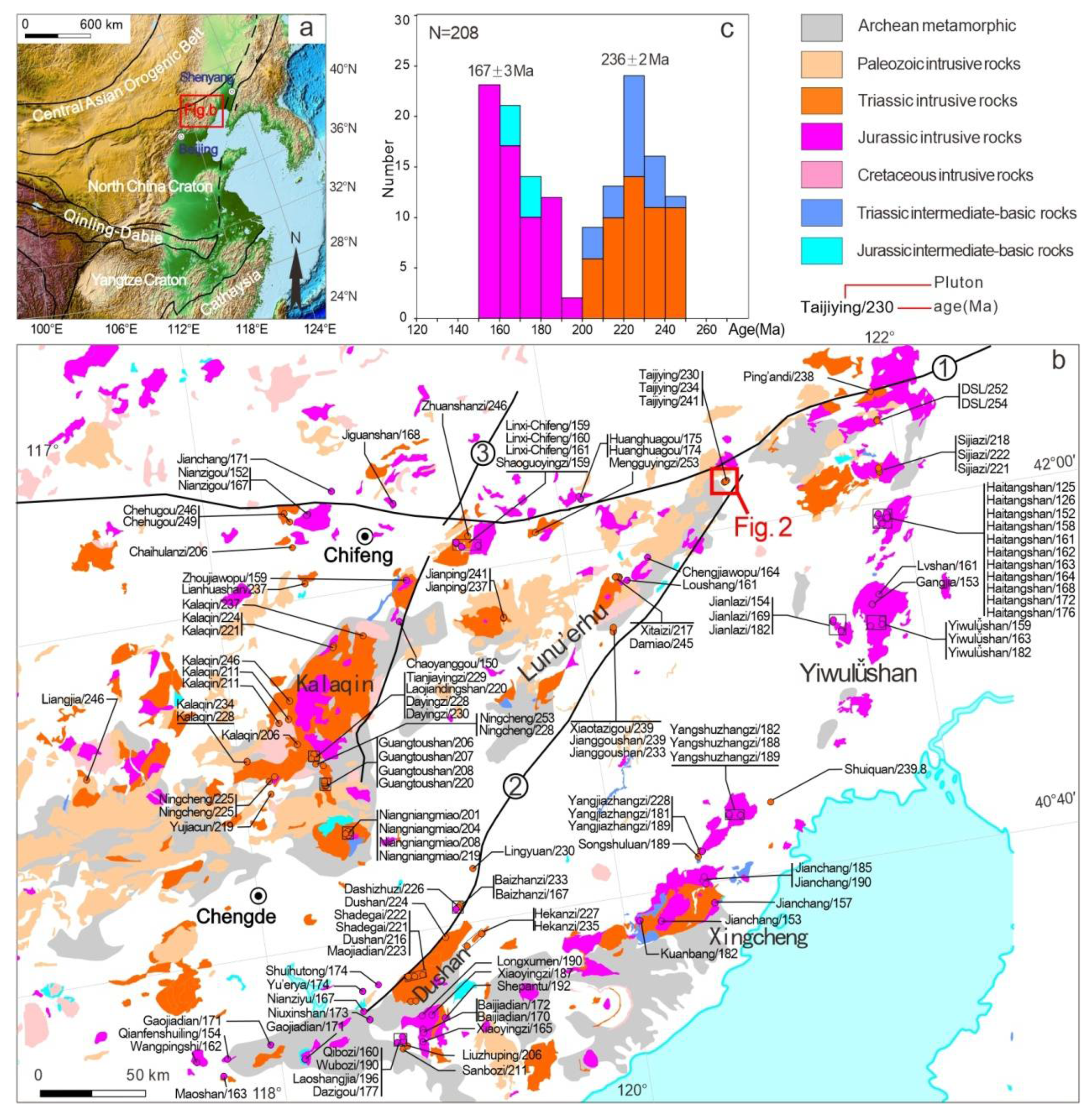
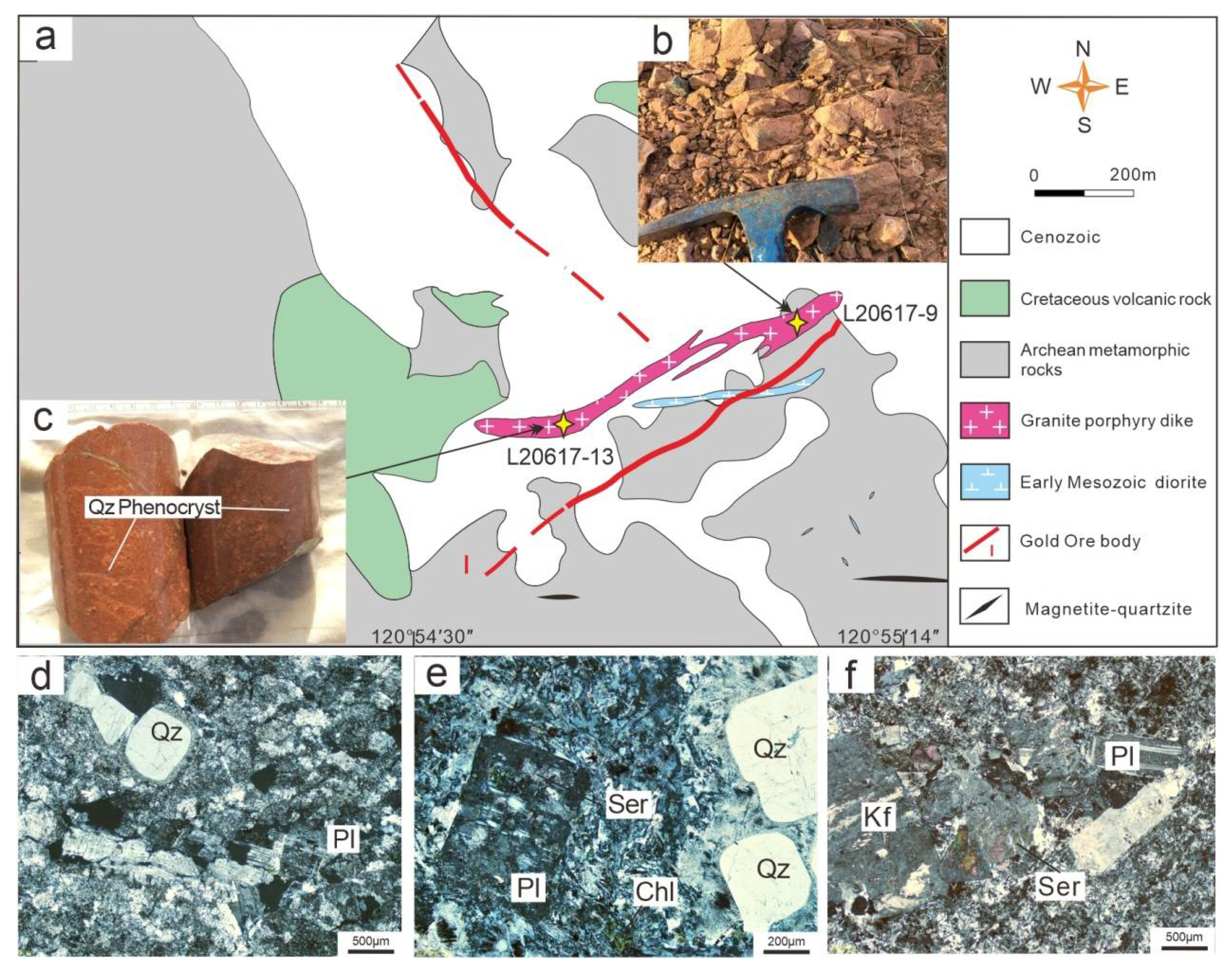
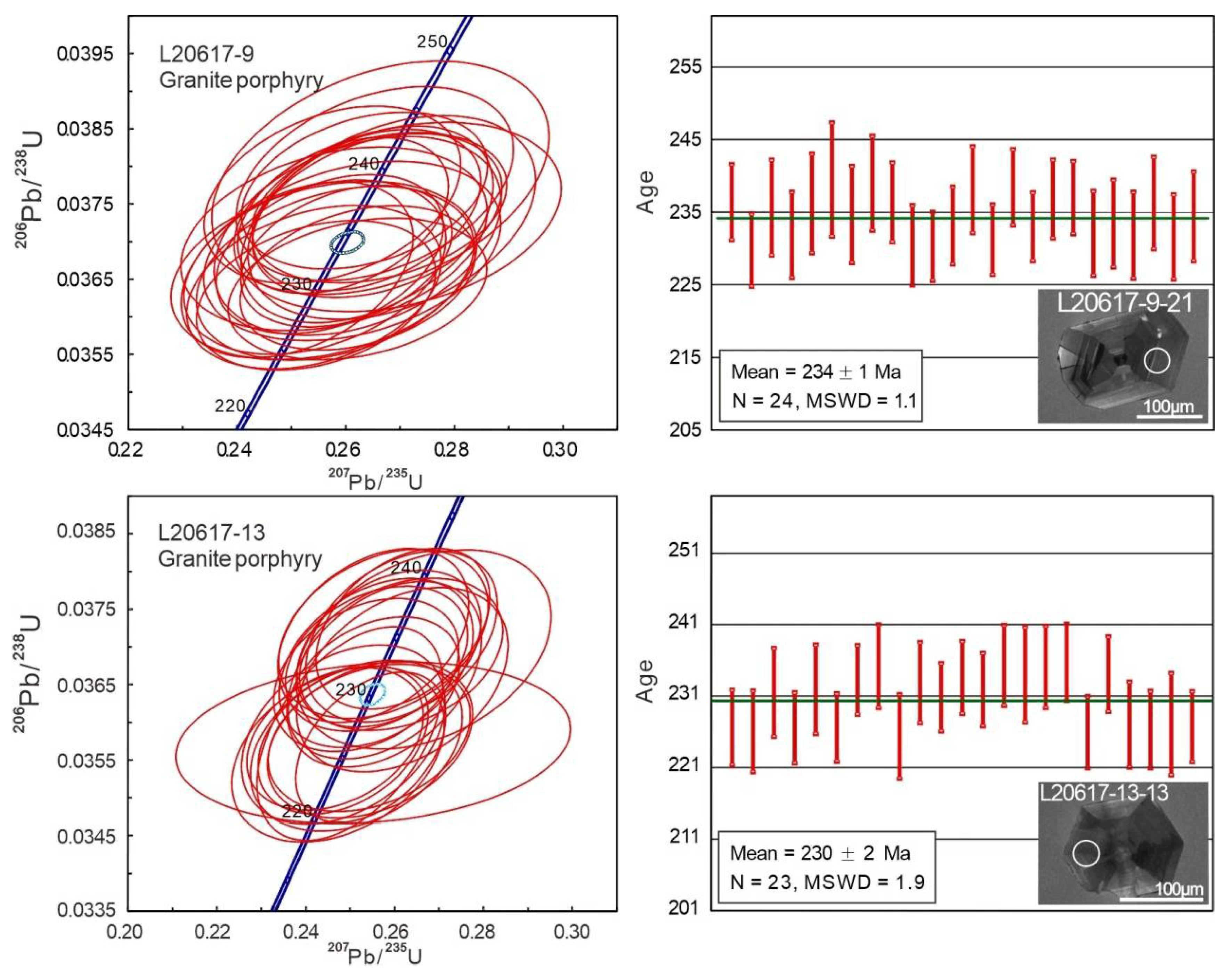
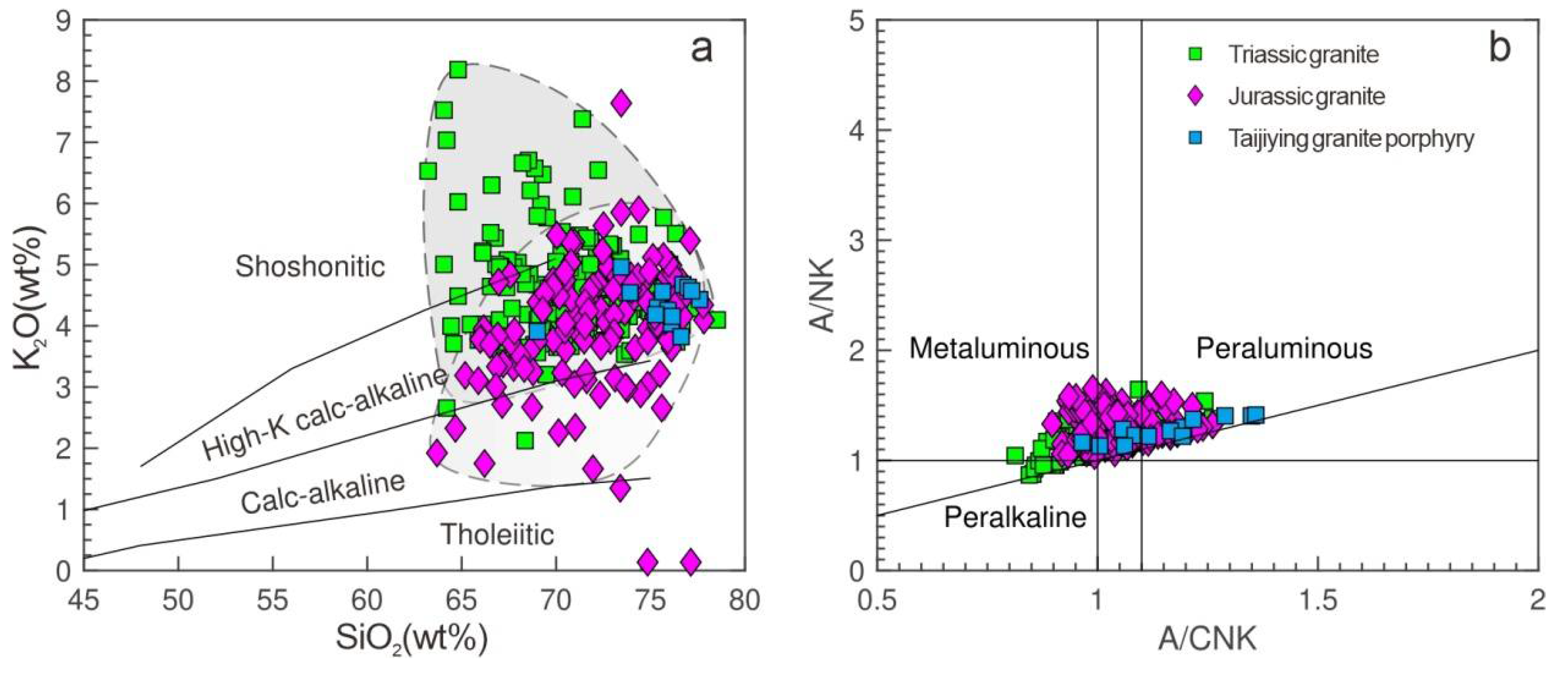
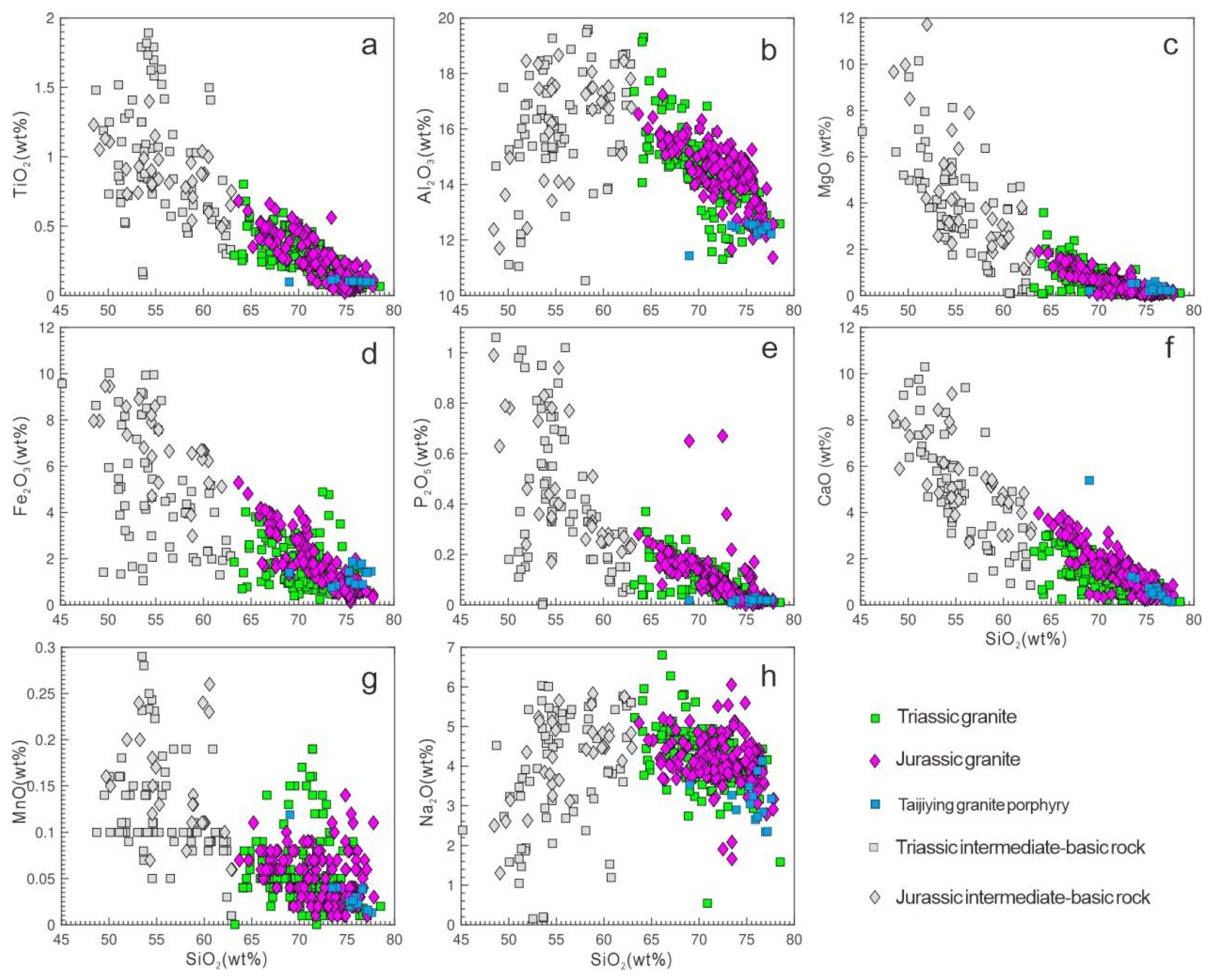
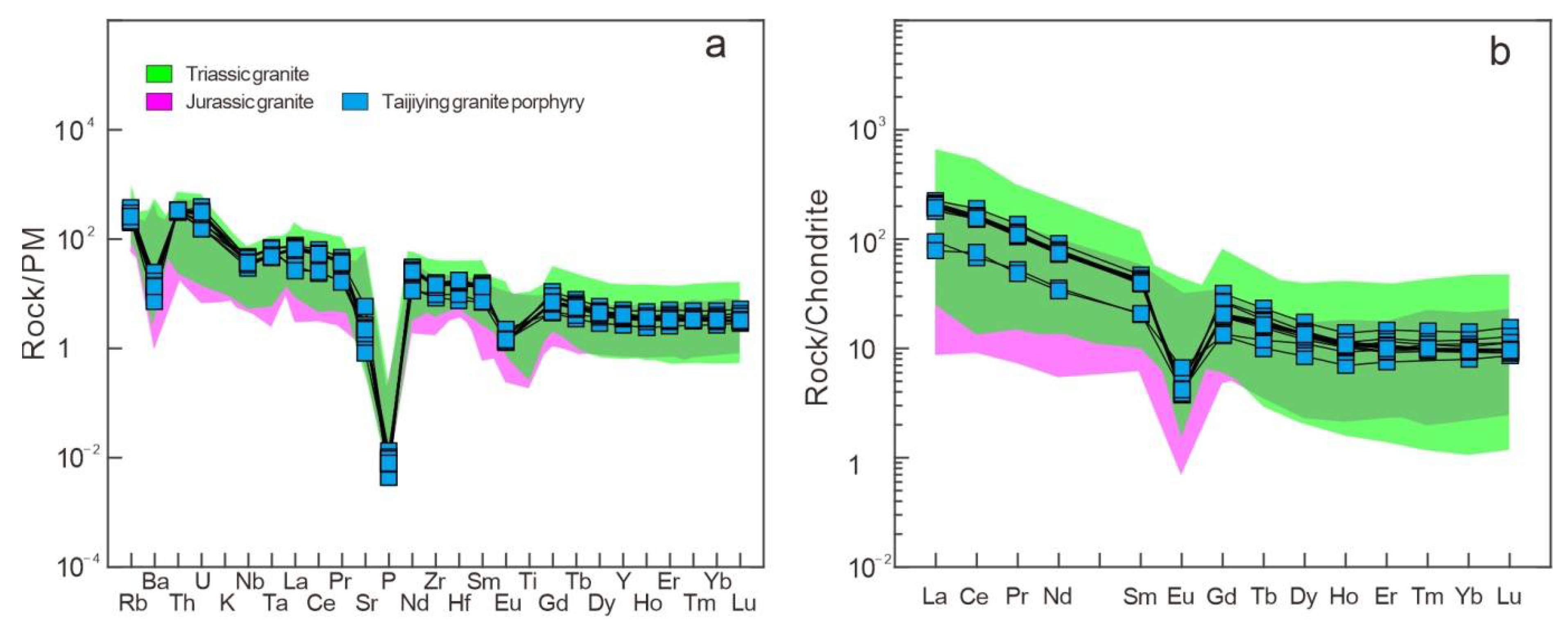
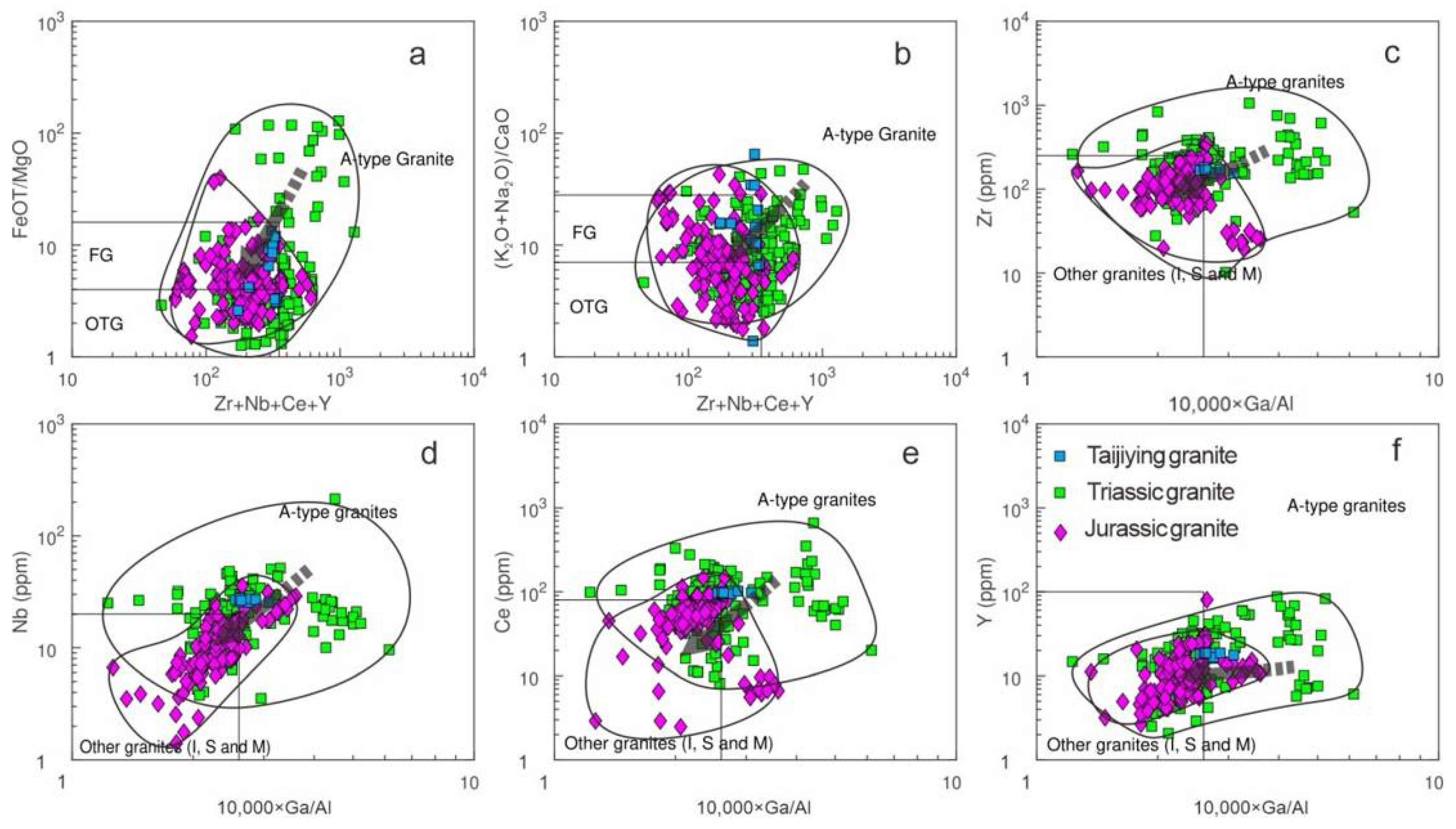
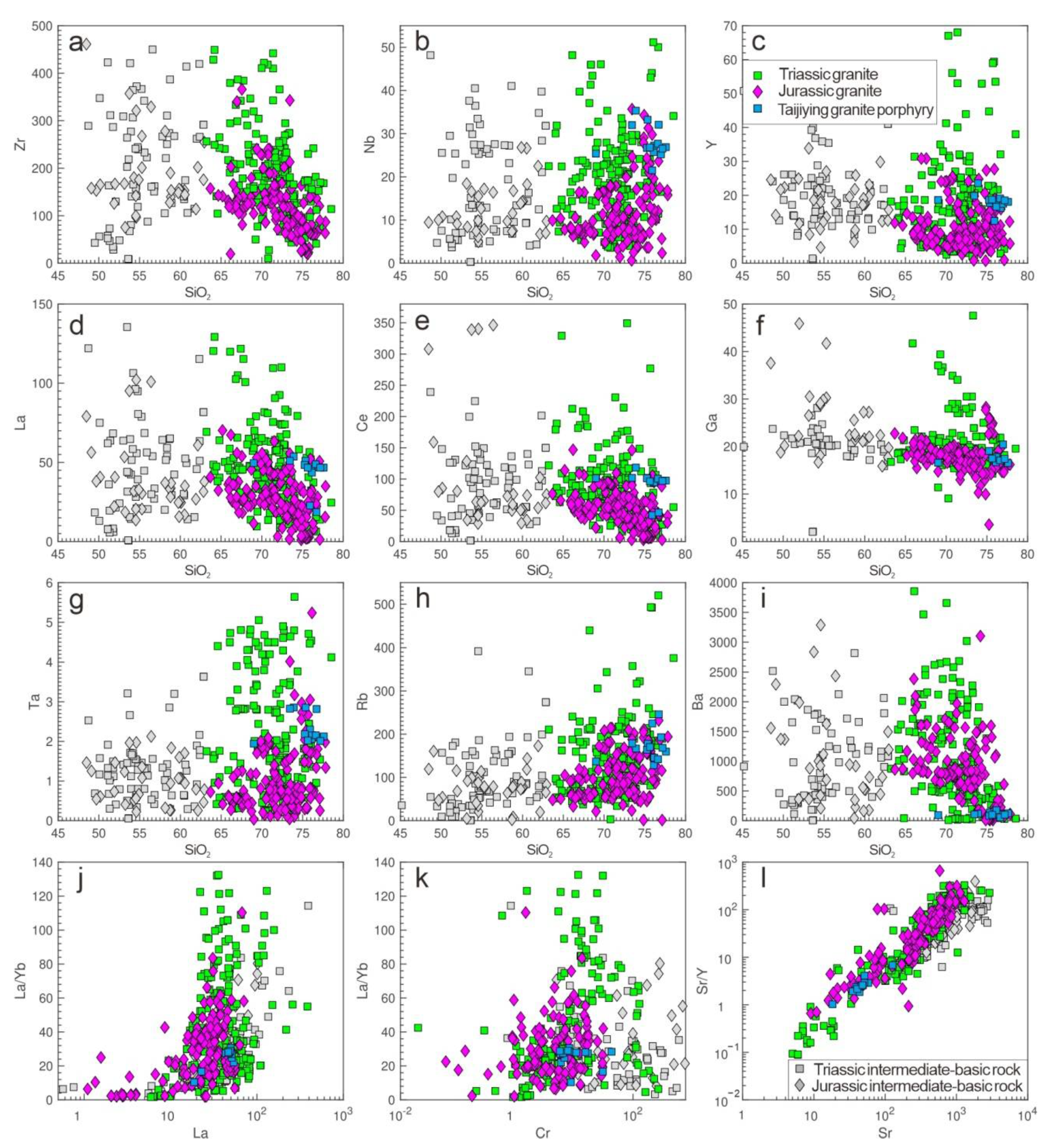
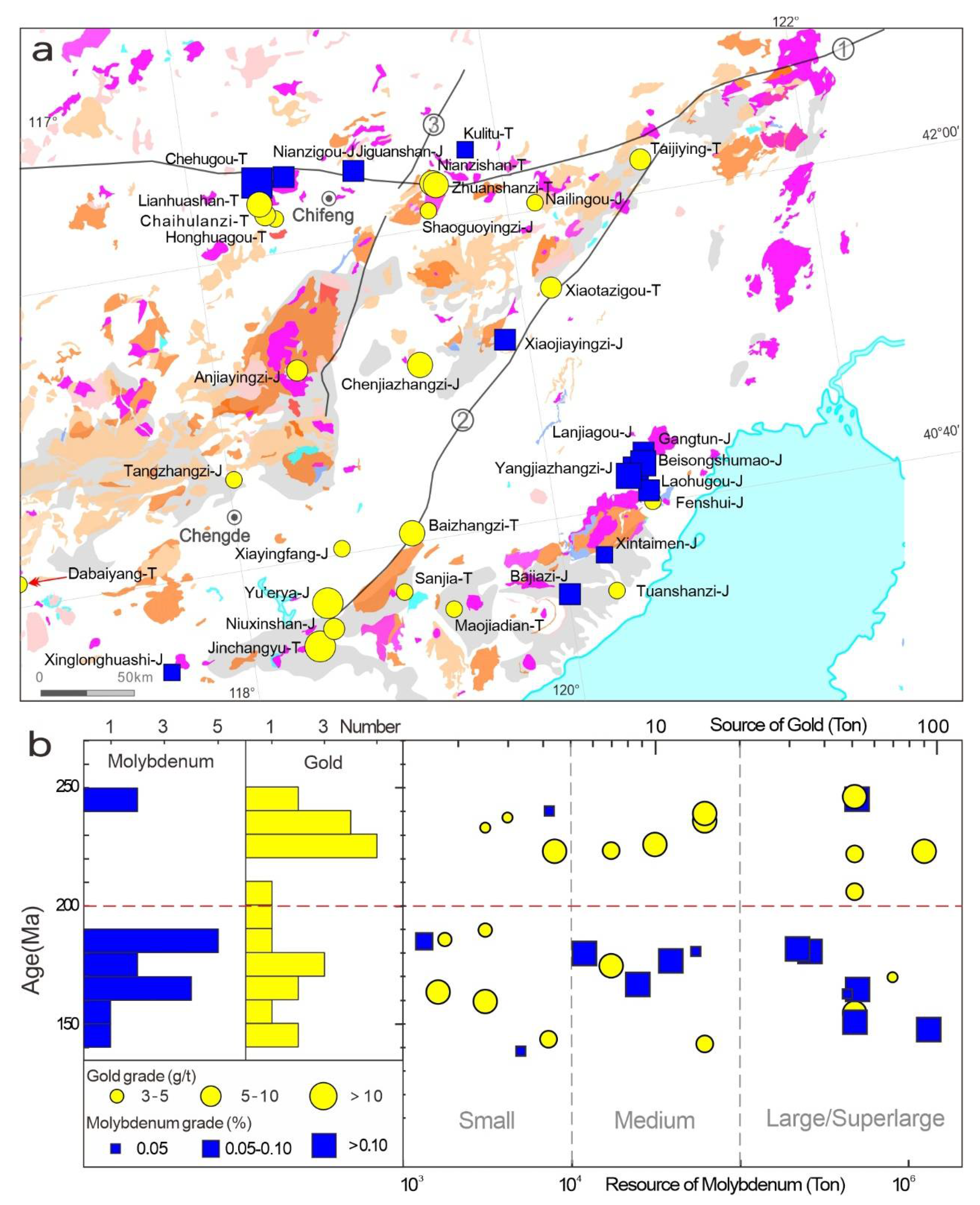
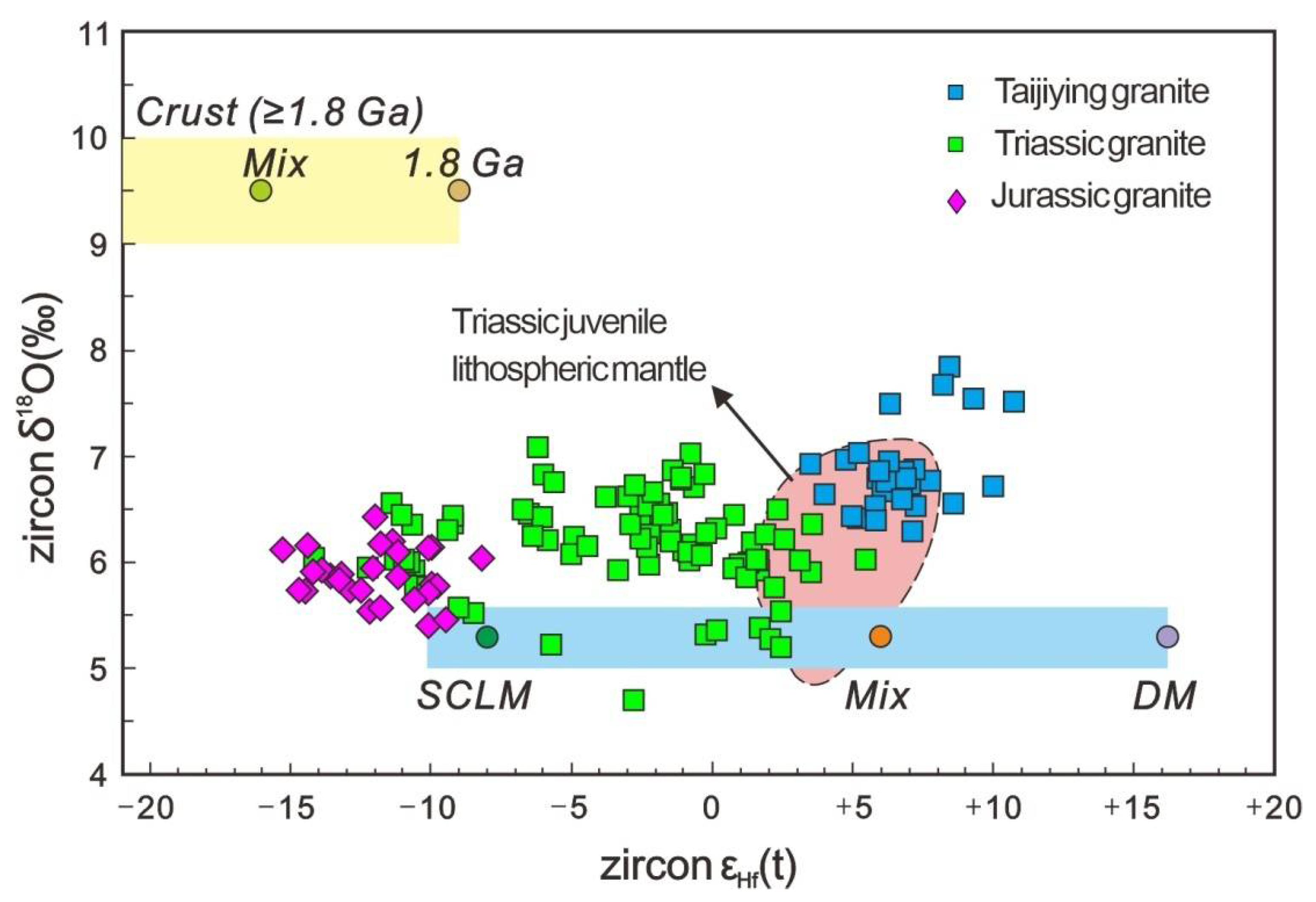
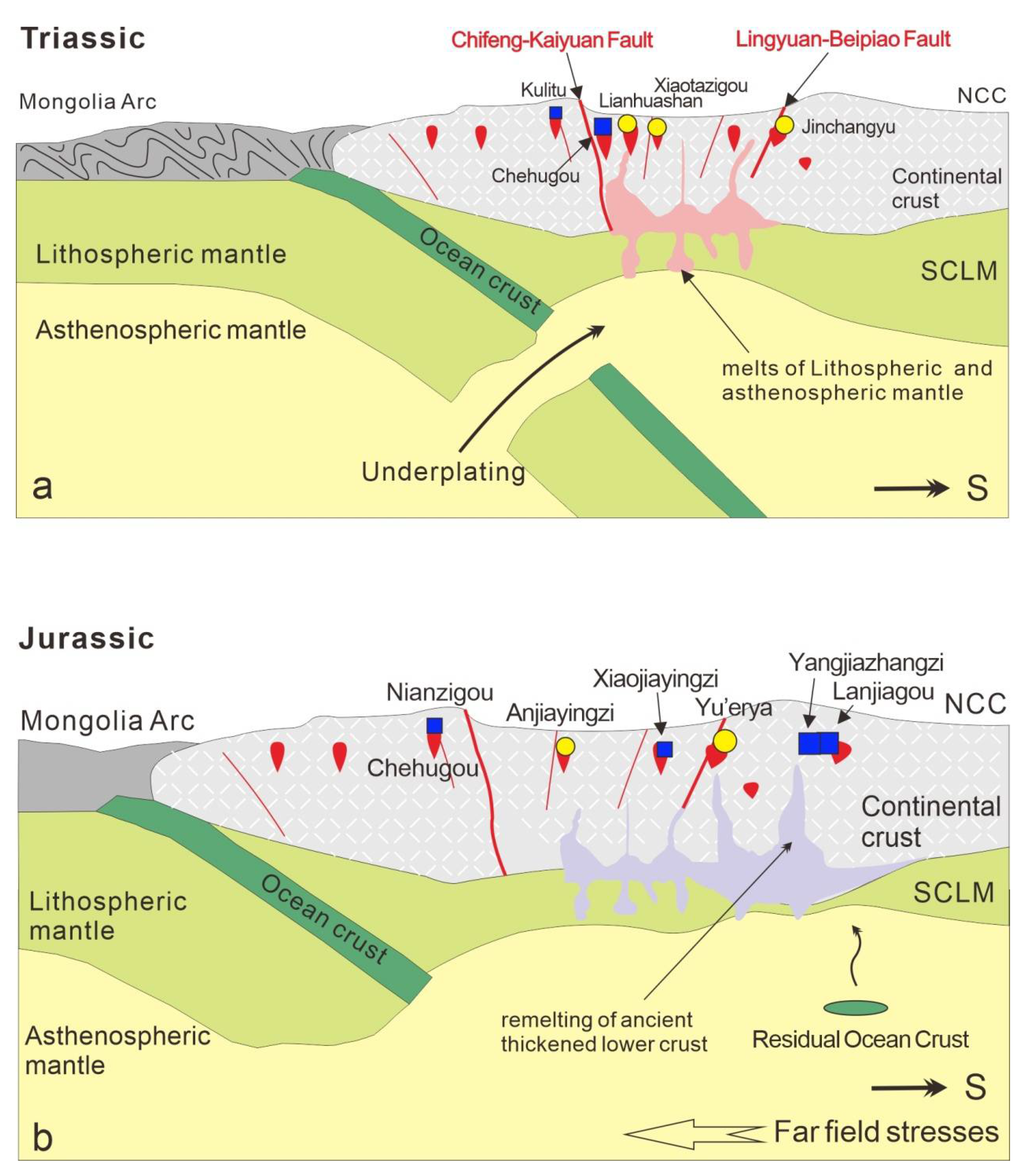
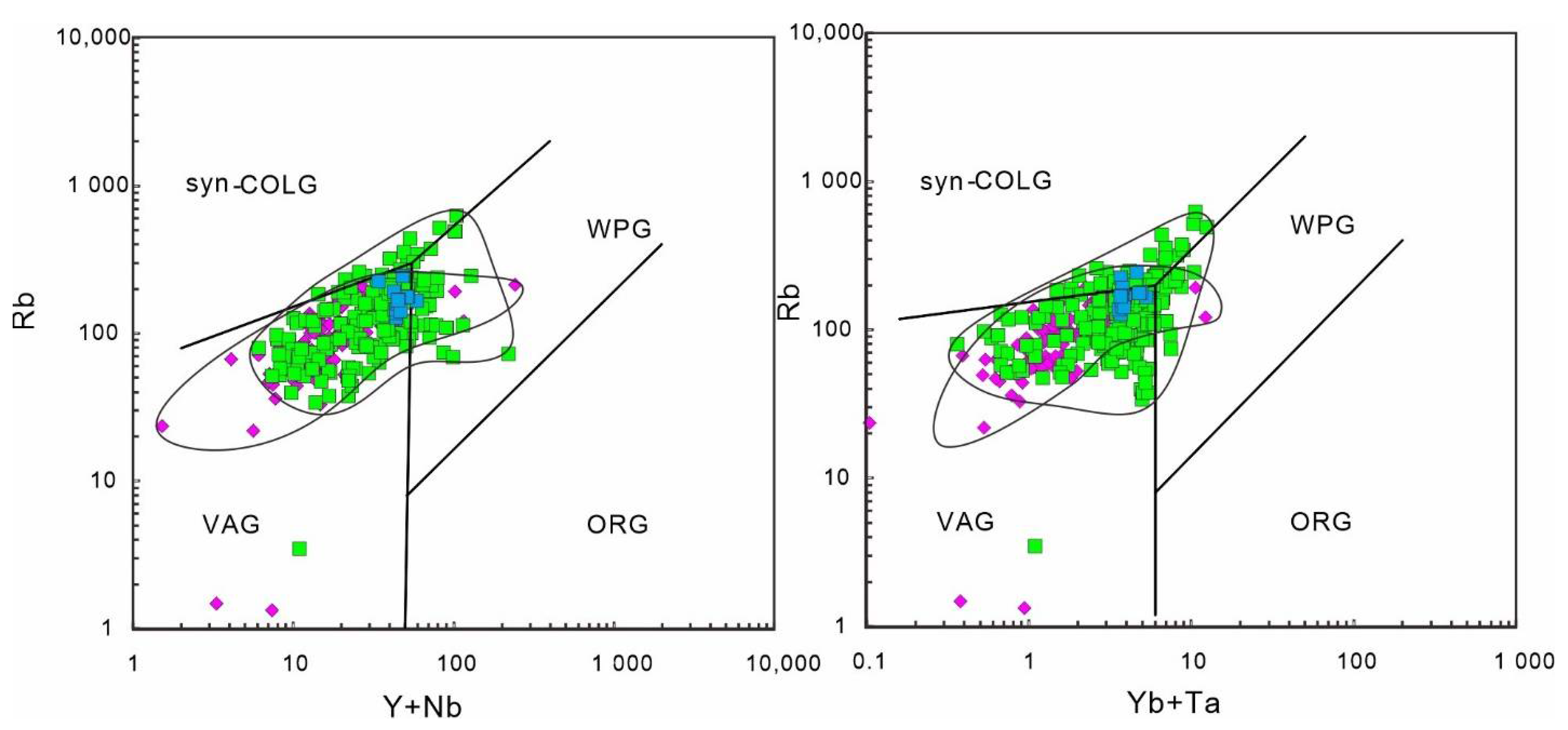
| Spots | Content (ppm) | Ratios | Age | |||||||||||||
|---|---|---|---|---|---|---|---|---|---|---|---|---|---|---|---|---|
| Total Pb | 232Th | 238U | Th/ U | 207Pb/206Pb | 1σ | 207Pb/235U | 1σ | 206Pb/238U | 1σ | 207Pb/206Pb | 1σ | 207Pb/235U | 1σ | 206Pb/238U | 1σ | |
| L20617-9, granite porphyry, 24 spots, weighted mean age = 234.2 ± 1.1 Ma, MSWD = 1.07 | ||||||||||||||||
| L20617-9-01 | 86.32 | 1218 | 1750 | 0.7 | 0.0499 | 0.0016 | 0.2595 | 0.0079 | 0.0374 | 0.0004 | 191 | 72.21 | 234 | 6.4 | 236 | 2.64 |
| L20617-9-03 | 58.06 | 682 | 1236 | 0.55 | 0.0498 | 0.0023 | 0.2545 | 0.009 | 0.0363 | 0.0004 | 183 | 107.39 | 230 | 7.28 | 230 | 2.53 |
| L20617-9-04 | 61.48 | 640 | 1289 | 0.5 | 0.0505 | 0.002 | 0.2639 | 0.0095 | 0.0372 | 0.0005 | 217 | 94.43 | 238 | 7.61 | 236 | 3.32 |
| L20617-9-05 | 91.15 | 1437 | 1836 | 0.78 | 0.0487 | 0.0017 | 0.251 | 0.0087 | 0.0366 | 0.0005 | 200 | 81.47 | 227 | 7.08 | 232 | 2.97 |
| L20617-9-06 | 62.56 | 702 | 1299 | 0.54 | 0.0513 | 0.0021 | 0.2684 | 0.0108 | 0.0373 | 0.0006 | 254 | 96.28 | 241 | 8.67 | 236 | 3.44 |
| L20617-9-07 | 50.1 | 477 | 1051 | 0.45 | 0.0501 | 0.0026 | 0.2663 | 0.0127 | 0.0379 | 0.0006 | 198 | 124.98 | 240 | 10.18 | 240 | 3.94 |
| L20617-9-08 | 64.96 | 771 | 1333 | 0.58 | 0.0505 | 0.0022 | 0.2622 | 0.0108 | 0.0371 | 0.0005 | 220 | 102.76 | 236 | 8.69 | 235 | 3.36 |
| L20617-9-09 | 55.89 | 470 | 1186 | 0.4 | 0.0503 | 0.002 | 0.2653 | 0.0104 | 0.0378 | 0.0005 | 209 | 87.95 | 239 | 8.38 | 239 | 3.27 |
| L20617-9-10 | 60.91 | 665 | 1250 | 0.53 | 0.0509 | 0.0018 | 0.2658 | 0.0094 | 0.0373 | 0.0004 | 235 | 86.1 | 239 | 7.53 | 236 | 2.77 |
| L20617-9-11 | 46.02 | 510 | 1005 | 0.51 | 0.0502 | 0.0019 | 0.2541 | 0.0096 | 0.0364 | 0.0004 | 211 | 88.88 | 230 | 7.75 | 230 | 2.76 |
| L20617-9-12 | 62.63 | 709 | 1321 | 0.54 | 0.0519 | 0.002 | 0.2621 | 0.0097 | 0.0364 | 0.0004 | 280 | 87.03 | 236 | 7.84 | 230 | 2.39 |
| L20617-9-13 | 70.83 | 906 | 1447 | 0.63 | 0.0504 | 0.0017 | 0.257 | 0.0085 | 0.0368 | 0.0004 | 213 | 43.51 | 232 | 6.91 | 233 | 2.69 |
| L20617-9-14 | 59.51 | 778 | 1205 | 0.65 | 0.0494 | 0.0018 | 0.2575 | 0.0097 | 0.0376 | 0.0005 | 165 | 87.95 | 233 | 7.8 | 238 | 2.99 |
| L20617-9-15 | 80.24 | 928 | 1673 | 0.55 | 0.0518 | 0.0017 | 0.2622 | 0.0088 | 0.0365 | 0.0004 | 276 | 69.44 | 236 | 7.12 | 231 | 2.44 |
| L20617-9-16 | 84.37 | 1088 | 1689 | 0.64 | 0.0505 | 0.0018 | 0.2635 | 0.0093 | 0.0377 | 0.0004 | 220 | 49.07 | 237 | 7.44 | 238 | 2.65 |
| L20617-9-17 | 97.14 | 1446 | 1926 | 0.75 | 0.0509 | 0.0016 | 0.2601 | 0.0079 | 0.0368 | 0.0004 | 239 | 70.36 | 235 | 6.4 | 233 | 2.39 |
| L20617-9-18 | 85.92 | 1310 | 1687 | 0.78 | 0.0507 | 0.0016 | 0.2638 | 0.0086 | 0.0374 | 0.0004 | 228 | 74.06 | 238 | 6.91 | 237 | 2.72 |
| L20617-9-19 | 84.23 | 1161 | 1669 | 0.7 | 0.051 | 0.0018 | 0.2661 | 0.0096 | 0.0375 | 0.0004 | 239 | 83.32 | 240 | 7.69 | 237 | 2.54 |
| L20617-9-20 | 55.45 | 609 | 1189 | 0.51 | 0.0498 | 0.0022 | 0.2543 | 0.0099 | 0.0367 | 0.0005 | 187 | 103.69 | 230 | 7.98 | 232 | 2.94 |
| L20617-9-21 | 51.08 | 537 | 1093 | 0.49 | 0.0508 | 0.0022 | 0.2612 | 0.0112 | 0.0369 | 0.0005 | 232 | 101.84 | 236 | 9 | 233 | 3.03 |
| L20617-9-22 | 92.16 | 1452 | 1840 | 0.79 | 0.0498 | 0.0026 | 0.2559 | 0.0115 | 0.0366 | 0.0005 | 183 | 120.36 | 231 | 9.3 | 232 | 3.01 |
| L20617-9-23 | 39.61 | 254 | 882 | 0.29 | 0.0517 | 0.0024 | 0.2695 | 0.0123 | 0.0373 | 0.0005 | 333 | 104.62 | 242 | 9.85 | 236 | 3.19 |
| L20617-9-24 | 49.55 | 313 | 1134 | 0.28 | 0.0506 | 0.0022 | 0.258 | 0.0104 | 0.0366 | 0.0005 | 233 | 98.14 | 233 | 8.43 | 232 | 2.94 |
| L20617-9-25 | 37.27 | 422 | 804 | 0.52 | 0.0497 | 0.0022 | 0.2578 | 0.0115 | 0.037 | 0.0005 | 189 | 103.69 | 233 | 9.3 | 234 | 3.1 |
| L20617-13, granite porphyry, 23 spots, weighted mean age = 231 ± 2.4 Ma, MSWD = 1.9 | ||||||||||||||||
| L20617-13-01 | 64.45 | 792 | 1401 | 0.57 | 0.0509 | 0.0019 | 0.2544 | 0.0094 | 0.0358 | 0.0004 | 239 | 88.88 | 230 | 7.65 | 227 | 2.65 |
| L20617-13-02 | 60.14 | 613 | 1322 | 0.46 | 0.0502 | 0.0025 | 0.2514 | 0.0098 | 0.0357 | 0.0005 | 211 | 116.65 | 228 | 7.91 | 226 | 2.87 |
| L20617-13-03 | 72.1 | 1044 | 1539 | 0.68 | 0.0512 | 0.0019 | 0.2617 | 0.0097 | 0.0366 | 0.0005 | 250 | 89.8 | 236 | 7.82 | 232 | 3.11 |
| L20617-13-06 | 86.17 | 1545 | 1787 | 0.87 | 0.0499 | 0.0016 | 0.2484 | 0.0078 | 0.0358 | 0.0004 | 191 | 74.06 | 225 | 6.37 | 227 | 2.5 |
| L20617-13-07 | 74.82 | 899 | 1689 | 0.53 | 0.0501 | 0.0019 | 0.2576 | 0.009 | 0.0366 | 0.0005 | 198 | 90.73 | 233 | 7.24 | 232 | 3.13 |
| L20617-13-08 | 98.93 | 1473 | 1974 | 0.75 | 0.0496 | 0.0017 | 0.2466 | 0.0081 | 0.0358 | 0.0004 | 176 | 79.62 | 224 | 6.62 | 227 | 2.4 |
| L20617-13-09 | 76.28 | 1119 | 1561 | 0.72 | 0.0499 | 0.0016 | 0.2559 | 0.0084 | 0.0368 | 0.0004 | 191 | 71.29 | 231 | 6.78 | 233 | 2.44 |
| L20617-13-10 | 78.11 | 1082 | 1617 | 0.67 | 0.0495 | 0.0017 | 0.2552 | 0.0088 | 0.0372 | 0.0005 | 169 | 84.25 | 231 | 7.1 | 235 | 2.93 |
| L20617-13-11 | 51.49 | 583 | 1145 | 0.51 | 0.0502 | 0.0021 | 0.2472 | 0.0098 | 0.0356 | 0.0005 | 206 | 98.13 | 224 | 7.97 | 225 | 2.96 |
| L20617-13-12 | 46.08 | 500 | 995 | 0.5 | 0.0502 | 0.0017 | 0.2558 | 0.0089 | 0.0368 | 0.0005 | 206 | 79.62 | 231 | 7.21 | 233 | 2.85 |
| L20617-13-13 | 76.42 | 989 | 1603 | 0.62 | 0.0504 | 0.0015 | 0.2553 | 0.0079 | 0.0365 | 0.0004 | 213 | 72.21 | 231 | 6.37 | 231 | 2.4 |
| L20617-13-14 | 35.82 | 321 | 774 | 0.41 | 0.0509 | 0.0018 | 0.2614 | 0.0094 | 0.0369 | 0.0004 | 235 | 81.47 | 236 | 7.53 | 234 | 2.57 |
| L20617-13-15 | 53.56 | 520 | 1146 | 0.45 | 0.0497 | 0.002 | 0.2536 | 0.0085 | 0.0366 | 0.0004 | 189 | 94.43 | 229 | 6.9 | 232 | 2.58 |
| L20617-13-16 | 61.1 | 635 | 1277 | 0.5 | 0.0498 | 0.0019 | 0.2574 | 0.0096 | 0.0372 | 0.0005 | 183 | 119.43 | 233 | 7.78 | 235 | 2.86 |
| L20617-13-18 | 35.99 | 303 | 782 | 0.39 | 0.0519 | 0.0023 | 0.2665 | 0.0117 | 0.037 | 0.0005 | 280 | 106.47 | 240 | 9.39 | 234 | 3.35 |
| L20617-13-19 | 77.43 | 930 | 1591 | 0.58 | 0.0506 | 0.0017 | 0.2615 | 0.0088 | 0.0371 | 0.0005 | 220 | 75.91 | 236 | 7.09 | 235 | 2.89 |
| L20617-13-20 | 112.76 | 1800 | 2200 | 0.82 | 0.0507 | 0.0015 | 0.2618 | 0.008 | 0.0372 | 0.0004 | 233 | 70.36 | 236 | 6.42 | 236 | 2.71 |
| L20617-13-22 | 105.11 | 1834 | 2133 | 0.86 | 0.0514 | 0.0014 | 0.2546 | 0.0069 | 0.0357 | 0.0004 | 261 | 61.1 | 230 | 5.6 | 226 | 2.54 |
| L20617-13-23 | 53.53 | 562 | 1152 | 0.49 | 0.0505 | 0.0016 | 0.2587 | 0.0085 | 0.037 | 0.0004 | 217 | 80.54 | 234 | 6.83 | 234 | 2.64 |
| L20617-13-24 | 31.08 | 308 | 704 | 0.44 | 0.05 | 0.0018 | 0.2484 | 0.0094 | 0.0358 | 0.0005 | 195 | 85.17 | 225 | 7.62 | 227 | 3.02 |
| L20617-13-25 | 71.13 | 900 | 1381 | 0.65 | 0.0504 | 0.0033 | 0.2551 | 0.0182 | 0.0357 | 0.0004 | 213 | 149.98 | 231 | 14.69 | 226 | 2.72 |
| L20617-13-26 | 96.29 | 1775 | 1937 | 0.92 | 0.0511 | 0.0019 | 0.2499 | 0.0085 | 0.0359 | 0.0006 | 256 | 80.54 | 227 | 6.94 | 227 | 3.6 |
| L20617-13-27 | 47.77 | 510 | 1056 | 0.48 | 0.0511 | 0.0022 | 0.2542 | 0.0093 | 0.0358 | 0.0004 | 256 | 98.14 | 230 | 7.53 | 227 | 2.48 |
| Samples | L20617-1-1 | L20617-2-1 | L20617-3-1 | L20617-4-1 | L20617-5-1 | L20617-7 | L20617-8 | L20617-9 | L20617-10 | L20617-11 | L20617-12 | L20617-13 | L20617-14 | L20617-15 |
|---|---|---|---|---|---|---|---|---|---|---|---|---|---|---|
| Major elements (wt.%) | ||||||||||||||
| SiO2 | 73.9 | 73.4 | 75.3 | 75.9 | 76.7 | 76.1 | 69.0 | 76.2 | 75.3 | 77.0 | 77.6 | 75.7 | 76.6 | 77.2 |
| TiO2 | 0.12 | 0.11 | 0.11 | 0.11 | 0.09 | 0.10 | 0.10 | 0.10 | 0.11 | 0.10 | 0.10 | 0.11 | 0.10 | 0.10 |
| Al2O3 | 12.5 | 12.5 | 12.6 | 12.6 | 12.3 | 12.2 | 11.4 | 12.3 | 12.6 | 12.5 | 12.2 | 12.6 | 12.3 | 12.5 |
| Fe2O3 | 0.83 | 0.76 | 1.02 | 0.89 | 0.90 | 1.67 | 1.40 | 1.72 | 1.42 | 1.41 | 1.46 | 1.88 | 1.77 | 1.39 |
| MnO | 0.04 | 0.04 | 0.02 | 0.03 | 0.04 | 0.02 | 0.12 | 0.02 | 0.03 | 0.02 | 0.01 | 0.03 | 0.04 | 0.02 |
| MgO | 0.53 | 0.53 | 0.49 | 0.61 | 0.40 | 0.18 | 0.20 | 0.38 | 0.19 | 0.21 | 0.20 | 0.28 | 0.21 | 0.22 |
| CaO | 1.15 | 1.23 | 0.48 | 0.44 | 0.48 | 0.75 | 5.40 | 0.61 | 0.74 | 0.20 | 0.12 | 0.54 | 0.39 | 0.20 |
| Na2O | 2.90 | 3.27 | 3.04 | 2.65 | 2.84 | 3.89 | 3.52 | 2.72 | 3.48 | 2.35 | 3.18 | 3.24 | 4.12 | 2.36 |
| K2O | 4.55 | 4.96 | 4.30 | 4.25 | 4.67 | 4.04 | 3.92 | 4.15 | 4.19 | 4.63 | 4.44 | 4.56 | 3.82 | 4.58 |
| P2O5 | 0.02 | 0.01 | 0.01 | 0.03 | 0.02 | 0.02 | 0.02 | 0.02 | 0.02 | 0.02 | 0.02 | 0.02 | 0.02 | 0.02 |
| LOI | 2.09 | 1.80 | 1.50 | 0.96 | 1.07 | 1.12 | 4.93 | 1.58 | 1.32 | 1.19 | 0.83 | 1.28 | 0.91 | 1.28 |
| Total | 99.60 | 99.63 | 99.59 | 99.26 | 100.41 | 100.10 | 100.06 | 99.72 | 99.36 | 99.55 | 100.16 | 100.13 | 100.35 | 99.86 |
| FeO | 1.03 | 0.96 | 0.69 | 0.79 | 0.86 | 0.90 | 0.72 | 0.92 | 0.60 | 0.65 | 0.64 | 1.12 | 0.97 | 0.64 |
| FeOT | 1.78 | 1.64 | 1.61 | 1.59 | 1.67 | 2.41 | 1.98 | 2.46 | 1.88 | 1.92 | 1.95 | 2.81 | 2.56 | 1.89 |
| Mg# | 38.48 | 40.34 | 38.99 | 44.57 | 33.44 | 13.62 | 17.57 | 24.29 | 17.32 | 18.48 | 17.83 | 17.50 | 14.91 | 19.85 |
| K2O/Na2O | 1.57 | 1.52 | 1.41 | 1.60 | 1.64 | 1.04 | 1.11 | 1.53 | 1.20 | 1.97 | 1.40 | 1.41 | 0.93 | 1.94 |
| A/CNK | 1.06 | 0.96 | 1.20 | 1.29 | 1.16 | 1.01 | 0.58 | 1.22 | 1.09 | 1.35 | 1.19 | 1.12 | 1.06 | 1.36 |
| Tzr | 787 | 774 | 809 | 804 | 801 | 786 | 702 | 800 | 784 | 809 | 805 | 903 | 906 | 924 |
| Trace elements (ppm) | ||||||||||||||
| Li | 3.16 | 3.94 | 12.2 | 4.97 | 8.61 | 4.08 | 3.67 | 1.97 | 3.63 | |||||
| Be | 1.79 | 2.20 | 2.43 | 2.31 | 2.89 | 2.02 | 1.68 | 1.83 | 1.79 | |||||
| Sc | 1.52 | 1.42 | 1.28 | 1.64 | 1.34 | 1.29 | 1.39 | 1.52 | 1.28 | |||||
| V | 8.31 | 8.14 | 8.29 | 12.3 | 6.50 | 1.98 | 1.87 | 2.56 | 1.72 | 2.72 | 2.47 | 5.72 | 1.46 | 6.25 |
| Cr | 5.81 | 6.61 | 5.63 | 30.1 | 8.56 | 42.9 | 8.06 | 6.28 | 8.24 | 10.5 | 5.53 | 16.9 | 7.56 | 15.1 |
| Co | 0.86 | 0.67 | 0.61 | 2.16 | 0.89 | 0.62 | 0.64 | 0.66 | 0.35 | 0.31 | 0.32 | 0.41 | 0.38 | 0.40 |
| Ni | 4.13 | 4.33 | 4.00 | 14.7 | 5.55 | 2.76 | 1.94 | 12.0 | 1.56 | 1.54 | 1.73 | 2.19 | 1.90 | 2.36 |
| Cu | 4.93 | 3.03 | 4.42 | 2.77 | 3.32 | 2.80 | 3.58 | 3.94 | 3.72 | |||||
| Zn | 29.6 | 22.3 | 25.3 | 26.3 | 38.6 | 28.2 | 36.0 | 32.2 | 36.7 | |||||
| Ga | 16.7 | 16.6 | 17.8 | 19.1 | 20.4 | 16.5 | 17.5 | 17.1 | 17.4 | |||||
| Rb | 167 | 179 | 178 | 225 | 246 | 128 | 137 | 145 | 164 | 193 | 160 | 171 | 142 | 168 |
| Sr | 43.7 | 57.9 | 51.3 | 50.9 | 41.9 | 44.0 | 127 | 39.0 | 46.3 | 18.2 | 34.9 | 48.5 | 40.5 | 48.4 |
| Y | 23.6 | 19.9 | 17.8 | 12.5 | 16.3 | 18.2 | 18.6 | 16.7 | 18.6 | 17.5 | 18.1 | 18.8 | 19.0 | 18.6 |
| Zr | 166 | 181 | 175 | 97.0 | 112 | 170 | 157 | 155 | 171 | 152 | 168 | 174 | 182 | 170 |
| Nb | 35.3 | 32.0 | 33.2 | 21.5 | 32.1 | 25.7 | 25.4 | 27.2 | 26.7 | 25.3 | 26.9 | 26.8 | 27.7 | 26.5 |
| Sn | 3.36 | 3.36 | 3.13 | 1.97 | 2.96 | 2.60 | 2.44 | 2.56 | 2.90 | 3.29 | 2.60 | 2.89 | 2.84 | 2.98 |
| Cs | 1.37 | 1.51 | 1.74 | 3.04 | 3.92 | 1.60 | 1.75 | 2.02 | 1.75 | |||||
| Ba | 117.0 | 105.0 | 138.0 | 150.0 | 117.0 | 120 | 94.5 | 175 | 82.7 | 107 | 122 | 100.0 | 52.5 | 98.1 |
| La | 53.7 | 50.9 | 51.0 | 22.8 | 18.7 | 46.0 | 49.6 | 43.5 | 48.4 | 47.0 | 46.7 | 46.8 | 48.8 | 46.8 |
| Ce | 118 | 102 | 102 | 42.2 | 46.7 | 94.8 | 101 | 94.4 | 101 | 97.5 | 97.5 | 96.3 | 100 | 96.9 |
| Pr | 13.2 | 11.1 | 11.2 | 5.04 | 4.64 | 10.2 | 10.9 | 10.3 | 10.8 | 10.5 | 10.6 | 10.5 | 10.9 | 10.4 |
| Nd | 42.7 | 36.6 | 36.3 | 16.9 | 15.9 | 34.5 | 37.7 | 35.5 | 36.7 | 35.9 | 36.3 | 34.7 | 36.5 | 34.9 |
| Sm | 7.29 | 6.21 | 5.98 | 3.18 | 3.25 | 6.13 | 6.49 | 6.26 | 6.24 | 6.36 | 6.70 | 6.45 | 6.39 | 6.16 |
| Eu | 0.22 | 0.27 | 0.29 | 0.39 | 0.24 | 0.23 | 0.25 | 0.24 | 0.23 | 0.25 | 0.24 | 0.23 | 0.23 | 0.25 |
| Gd | 6.62 | 5.60 | 5.50 | 2.71 | 2.81 | 4.04 | 4.31 | 4.00 | 4.24 | 4.21 | 4.26 | 4.13 | 4.32 | 4.22 |
| Tb | 0.88 | 0.75 | 0.69 | 0.38 | 0.45 | 0.61 | 0.65 | 0.59 | 0.63 | 0.61 | 0.68 | 0.61 | 0.67 | 0.63 |
| Dy | 4.43 | 3.69 | 3.39 | 2.18 | 2.85 | 3.49 | 3.44 | 3.09 | 3.44 | 3.26 | 3.44 | 3.50 | 3.54 | 3.44 |
| Ho | 0.79 | 0.65 | 0.59 | 0.40 | 0.53 | 0.60 | 0.61 | 0.58 | 0.65 | 0.60 | 0.61 | 0.63 | 0.66 | 0.61 |
| Er | 2.48 | 2.06 | 1.94 | 1.26 | 1.64 | 1.75 | 1.77 | 1.54 | 1.80 | 1.59 | 1.69 | 1.78 | 1.75 | 1.67 |
| Tm | 0.37 | 0.30 | 0.28 | 0. 20 | 0.28 | 0.25 | 0.25 | 0.24 | 0.26 | 0.25 | 0.25 | 0.25 | 0.26 | 0.26 |
| Yb | 2.43 | 2.06 | 1.89 | 1.37 | 1.78 | 1.63 | 1.62 | 1.59 | 1.70 | 1.68 | 1.63 | 1.70 | 1.69 | 1.67 |
| Lu | 0.40 | 0.33 | 0.29 | 0.22 | 0.29 | 0.24 | 0.23 | 0.23 | 0.25 | 0.24 | 0.25 | 0.25 | 0.25 | 0.25 |
| Hf | 4.42 | 4.56 | 4.44 | 2.40 | 3.06 | 5.49 | 4.92 | 5.12 | 5.49 | 5.21 | 5.33 | 5.62 | 5.57 | 5.59 |
| Ta | 2.86 | 2.83 | 2.86 | 2.30 | 2.82 | 2.06 | 1.95 | 2.16 | 2.19 | 2.10 | 2.13 | 2.02 | 2.15 | 2.01 |
| Tl | 0.79 | 0.88 | 0.95 | 1.07 | 1.14 | 1.09 | 1.06 | 0.91 | 1.08 | |||||
| Pb | 10.9 | 7.79 | 6.77 | 9.03 | 7.18 | 10.3 | 11.8 | 10.5 | 11.5 | |||||
| Th | 28.0 | 27.7 | 26.8 | 26.8 | 27.2 | 28.2 | 27.4 | 28.8 | 28.9 | 28.4 | 29.7 | 29.6 | 29.2 | 29.2 |
| U | 4.25 | 8.32 | 6.52 | 3.57 | 3.37 | 6.55 | 5.94 | 4.55 | 4.50 | 3.38 | 6.09 | 6.95 | 6.28 | 6.79 |
| Th/U | 6.58 | 3.32 | 4.10 | 7.51 | 8.06 | 4.30 | 4.62 | 6.33 | 6.42 | 8.39 | 4.87 | 4.26 | 4.66 | 4.30 |
| Rb/Sr | 3.82 | 3.10 | 3.46 | 4.42 | 5.88 | 2.92 | 1.08 | 3.73 | 3.55 | 10.63 | 4.57 | 3.52 | 3.50 | 3.48 |
| Zr/Y | 7.03 | 9.11 | 9.86 | 7.70 | 6.89 | 9.38 | 8.43 | 9.32 | 9.21 | 8.70 | 9.27 | 9.24 | 9.55 | 9.15 |
| Sr/Y | 1.85 | 2.91 | 2.88 | 4.07 | 2.57 | 2.42 | 6.82 | 2.34 | 2.49 | 1.04 | 1.93 | 2.58 | 2.13 | 2.61 |
| ΣREE | 253.62 | 222.28 | 221.31 | 99.28 | 100.09 | 204.44 | 218.76 | 202.06 | 216.38 | 209.95 | 210.89 | 207.89 | 216.40 | 208.11 |
| LREE/HREE | 12.79 | 13.40 | 14.21 | 10.38 | 8.43 | 15.22 | 15.97 | 16.04 | 15.68 | 15.88 | 15.48 | 15.19 | 15.47 | 15.34 |
| LaN/YbN | 15.8 | 17.7 | 19.4 | 11.9 | 7.6 | 20.3 | 22.0 | 19.6 | 20.4 | 20.0 | 20.6 | 19.8 | 20.8 | 20.1 |
| δEu | 0.10 | 0.14 | 0.15 | 0.40 | 0.24 | 0.14 | 0.14 | 0.14 | 0.14 | 0.15 | 0.14 | 0.14 | 0.13 | 0.15 |
| δCe | 1.06 | 1.00 | 1.00 | 0.92 | 1.19 | 1.07 | 1.07 | 1.09 | 1.08 | 1.08 | 1.07 | 1.06 | 1.07 | 1.08 |
| 86Rb/86Sr | 8.672 | 4.815 | 12.647 | 12.437 | 11.543 | 12.801 | ||||||||
| 87Sr/86Sr | 0.735249 | 0.720037 | 0.747575 | 0.748085 | 0.740880 | 0.749636 | ||||||||
| 2σ | 8 | 6 | 9 | 9 | 10 | 10 | ||||||||
| (87Sr/86Sr)i | 0.70688 | 0.70429 | 0.7062 | 0.7074 | 0.70312 | 0.70776 | ||||||||
| 147Sm/144Nd | 0.1022 | 0.1976 | 0.1530 | 0.1079 | 0.1564 | 0.1840 | ||||||||
| 143Nd/144Nd | 0.512582 | 0.51258 | 0.512588 | 0.512581 | 0.512583 | 0.512582 | ||||||||
| 2σ | 5 | 5 | 5 | 7 | 5 | 5 | ||||||||
| εNd(t) | 1.7 | −1.2 | 0.37 | 1.5 | 0.12 | −0.72 | ||||||||
| TDM2 | 870 | 1089 | 980 | 886 | 996 | 1060 | ||||||||
| fSm/Nd | −0.48 | −0.5 | −0.48 | −0.45 | −0.51 | −0.51 | ||||||||
| No. | Age (Ma) | 176Yb/177Hf | 176Lu/177Hf | 176Hf/177Hf | 2σ | εHf(0) | εHf(t) | TDM | TDMc | fLu/Hf | δ18O (‰) | ±2σ |
|---|---|---|---|---|---|---|---|---|---|---|---|---|
| L20617-9-01 | 234 | 0.055540 | 0.001231 | 0.282824 | 0.000035 | 1.82 | 6.78 | 610 | 831 | −0.96 | 6.69 | 0.15 |
| L20617-9-02 | 234 | 0.088477 | 0.001983 | 0.282748 | 0.000035 | −0.86 | 3.98 | 733 | 1011 | −0.94 | 6.64 | 0.18 |
| L20617-9-03 | 234 | 0.086536 | 0.001867 | 0.282834 | 0.000037 | 2.18 | 7.02 | 606 | 815 | −0.94 | 6.73 | 0.13 |
| L20617-9-04 | 234 | 0.101975 | 0.002190 | 0.282839 | 0.000034 | 2.38 | 7.20 | 603 | 805 | −0.93 | 6.53 | 0.17 |
| L20617-9-05 | 234 | 0.093398 | 0.001997 | 0.282854 | 0.000032 | 2.89 | 7.73 | 579 | 771 | −0.94 | 6.77 | 0.26 |
| L20617-9-06 | 234 | 0.068455 | 0.001532 | 0.282799 | 0.000034 | 0.94 | 5.86 | 651 | 891 | −0.95 | 6.79 | 0.17 |
| L20617-9-07 | 234 | 0.064702 | 0.001563 | 0.282820 | 0.000033 | 1.68 | 6.60 | 621 | 843 | −0.95 | 6.76 | 0.19 |
| L20617-9-08 | 234 | 0.047334 | 0.001183 | 0.282765 | 0.000029 | −0.24 | 4.72 | 693 | 964 | −0.96 | 6.96 | 0.07 |
| L20617-9-09 | 234 | 0.056710 | 0.001461 | 0.282778 | 0.000034 | 0.21 | 5.15 | 679 | 936 | −0.96 | 6.41 | 0.12 |
| L20617-9-10 | 234 | 0.091339 | 0.002086 | 0.282878 | 0.000030 | 3.73 | 8.55 | 546 | 718 | −0.94 | 6.55 | 0.23 |
| L20617-9-11 | 234 | 0.074405 | 0.001791 | 0.282834 | 0.000035 | 2.20 | 7.09 | 604 | 813 | −0.95 | 6.29 | 0.17 |
| L20617-9-12 | 234 | 0.075216 | 0.001717 | 0.282837 | 0.000032 | 2.28 | 7.17 | 600 | 808 | −0.95 | 6.87 | 0.14 |
| L20617-9-13 | 234 | 0.056767 | 0.001338 | 0.282772 | 0.000035 | −0.01 | 4.94 | 686 | 950 | −0.96 | 6.44 | 0.20 |
| L20617-9-14 | 234 | 0.050499 | 0.001185 | 0.282802 | 0.000029 | 1.07 | 6.03 | 640 | 880 | −0.96 | 6.67 | 0.14 |
| L20617-9-15 | 234 | 0.074764 | 0.001710 | 0.282915 | 0.000035 | 5.06 | 9.96 | 486 | 629 | −0.95 | 6.71 | 0.21 |
| L20617-13-01 | 230 | 0.074041 | 0.001555 | 0.282828 | 0.000030 | 1.97 | 6.79 | 610 | 828 | −0.95 | 6.85 | 0.14 |
| L20617-13-02 | 230 | 0.109095 | 0.002230 | 0.282816 | 0.000034 | 1.56 | 6.30 | 638 | 861 | −0.93 | 7.49 | 0.12 |
| L20617-13-03 | 230 | 0.093436 | 0.001965 | 0.282899 | 0.000032 | 4.49 | 9.27 | 513 | 671 | −0.94 | 7.54 | 0.16 |
| L20617-13-04 | 230 | 0.061286 | 0.001349 | 0.282798 | 0.000032 | 0.92 | 5.77 | 649 | 893 | −0.96 | 6.53 | 0.17 |
| L20617-13-05 | 230 | 0.112168 | 0.002389 | 0.282877 | 0.000030 | 3.71 | 8.42 | 551 | 724 | −0.93 | 7.84 | 0.18 |
| L20617-13-06 | 230 | 0.106823 | 0.002312 | 0.282941 | 0.000036 | 5.97 | 10.69 | 457 | 580 | −0.93 | 7.51 | 0.20 |
| L20617-13-07 | 230 | 0.098713 | 0.002224 | 0.282785 | 0.000035 | 0.47 | 5.20 | 683 | 930 | −0.93 | 7.03 | 0.25 |
| L20617-13-08 | 230 | 0.068805 | 0.001689 | 0.282810 | 0.000031 | 1.34 | 6.16 | 637 | 869 | −0.95 | 6.76 | 0.12 |
| L20617-13-09 | 230 | 0.059943 | 0.001473 | 0.282866 | 0.000032 | 3.32 | 8.17 | 554 | 741 | −0.96 | 7.67 | 0.20 |
| L20617-13-10 | 230 | 0.062086 | 0.001544 | 0.282734 | 0.000044 | −1.35 | 3.47 | 744 | 1040 | −0.95 | 6.93 | 0.21 |
| L20617-13-11 | 230 | 0.078422 | 0.001752 | 0.282831 | 0.000034 | 2.07 | 6.86 | 609 | 824 | −0.95 | 6.79 | 0.26 |
| L20617-13-12 | 230 | 0.071436 | 0.001551 | 0.282826 | 0.000033 | 1.91 | 6.72 | 612 | 832 | −0.95 | 6.59 | 0.16 |
| L20617-13-13 | 230 | 0.050549 | 0.001240 | 0.282811 | 0.000034 | 1.39 | 6.26 | 628 | 862 | −0.96 | 6.95 | 0.11 |
| L20617-13-14 | 230 | 0.071913 | 0.001660 | 0.282803 | 0.000035 | 1.10 | 5.91 | 647 | 885 | −0.95 | 6.86 | 0.31 |
| L20617-13-15 | 230 | 0.058868 | 0.001305 | 0.282798 | 0.000033 | 0.93 | 5.80 | 648 | 893 | −0.96 | 6.39 | 0.13 |
Publisher’s Note: MDPI stays neutral with regard to jurisdictional claims in published maps and institutional affiliations. |
© 2022 by the authors. Licensee MDPI, Basel, Switzerland. This article is an open access article distributed under the terms and conditions of the Creative Commons Attribution (CC BY) license (https://creativecommons.org/licenses/by/4.0/).
Share and Cite
Yuan, J.-G.; Zhang, H.-F.; Tong, Y.; Qu, Y.-Y.; Liu, R.-B.; Li, R.-W. Contrasting Sources and Related Metallogeny of the Triassic and Jurassic Granitoids in the Chifeng–Chaoyang District, Northern Margin of the North China Craton: A Review with New Data. Minerals 2022, 12, 1117. https://doi.org/10.3390/min12091117
Yuan J-G, Zhang H-F, Tong Y, Qu Y-Y, Liu R-B, Li R-W. Contrasting Sources and Related Metallogeny of the Triassic and Jurassic Granitoids in the Chifeng–Chaoyang District, Northern Margin of the North China Craton: A Review with New Data. Minerals. 2022; 12(9):1117. https://doi.org/10.3390/min12091117
Chicago/Turabian StyleYuan, Jian-Guo, Hua-Feng Zhang, Ying Tong, Yun-Yan Qu, Rui-Bin Liu, and Run-Wu Li. 2022. "Contrasting Sources and Related Metallogeny of the Triassic and Jurassic Granitoids in the Chifeng–Chaoyang District, Northern Margin of the North China Craton: A Review with New Data" Minerals 12, no. 9: 1117. https://doi.org/10.3390/min12091117
APA StyleYuan, J.-G., Zhang, H.-F., Tong, Y., Qu, Y.-Y., Liu, R.-B., & Li, R.-W. (2022). Contrasting Sources and Related Metallogeny of the Triassic and Jurassic Granitoids in the Chifeng–Chaoyang District, Northern Margin of the North China Craton: A Review with New Data. Minerals, 12(9), 1117. https://doi.org/10.3390/min12091117






